 By Pepper Parr By Pepper Parr
BURLINGTON, ON January 29, 2013 Did you know that CoBALT Connects is the managing partner of the City of Burlington’s public art program? They are! And they are going to be “on hand this Thursday and Sunday at various Burlington locations with New Brunswick artist Peter Powning as he makes “Cultural Mulch” with the community’s prized possessions, turning those objects’ outlines into the bronze cast that will form the facade of his piece.
Jeremy Freiburger, the media friendly maestro who sent us this information about the Cultural Mulch might be the only person in the room – along with the artist of course, who we are looking forward to meeting.
The city does not appear to have spent as much as a dime promoting this event.
The Spiral Stella sculpture that is going to be placed outside the Performing Arts Centre is going to be around for at least 100 years – if this world lasts that long. Tens of thousands of people will look at it and see what we thought was important to us as a community to tell the story of our past.
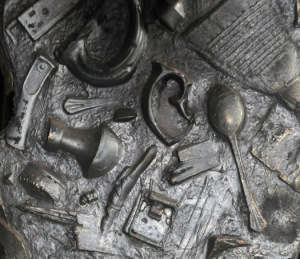 Powning wants to take artifacts the people of Burlington bring in – make a mold and then a casting that will be used in the sculpture. There have to be hundreds of people who have “stuff” in the attics or their basements that artist Peter Powning would like to consider.
 Touchstone was above all a collaborative community enterprise. My idea of asking the community to take part in creating it’s own narrative was the germ of the project. By providing me with objects and artifacts that had a part in defining Canmore for them personally, people gave me the source material for the bronze relief that is at the core of this sculpture. I wanted to encourage community involvement. But if people don’t bring out their artifacts – there won’t be anything to make a casting of and nothing for the public of the future to see.
At some point in the future there will be a tourist standing in front of the sculpture and asking: “Is that all this city has to show us about their past?”
Burlington has this annoying habit of getting the Mayor out there to have his picture taken every time there is a donation or an award being given. Last night he was at a table signing the Freeman Station Joint Venture document – a project he really didn’t get behind. At least we didn’t hear him say very much when the Friends of Freeman Station (FOFS) were struggling to find a home for the structure.
 Peter Powning on site in Canmore, Alberta where he installed touch stone, a sculpture along the same lines as the planned work for Burlington. Powning will be in Burlington so dig through the keep-sakes trunk and bring an object that matters to you. It’s a great way to be a part of the artistic process and to either contribute an object, or simply watch the process in action. Objects will not be damaged in the process, and will be returned after the mold is cast (about five minutes).
Sessions are on:
Thursday, January 31st: Burlington Public Library, Central Branch, 10 am to 3 pm
Thursday, January 31st: Burlington Performing Arts Centre, 7 pm to 9 pm
Sunday, February 3rd: Burlington Art Centre, 2 pm to 4 pm

 By Staff By Staff
BURLINGTON. ON. January 29, 2013 We see a couple of these reports each month and we can expect to see more as our population ages. A recent police media release went like this:
Male Missing: Elderly Man with Alzheimer’s Believed to Be Lost in the Toronto Area
The Halton Regional Police Service and the Toronto Police Service are seeking the assistance of the public in locating a missing elderly male person who is believed to be lost in the Toronto area.
The missing male person is a 82-year-old senior who resides in the City of Burlington in the Regional Municipality of Halton. The missing person has recently been diagnosed with Alzheimer’s. The missing person is dependent upon certain medications and his health may deteriorate without his prescribed medication, and may appear confused. The male will be reluctant to accept help if approached.
At approximately 10:53 p.m. a member of the Halton Regional Conservation Authority Parks Department was on routine patrol.
In this situation the follow up was a good news story:
A Parks Officer came upon the scene of a single motor vehicle collision on Milborough Town Line north of Campbellville Sideroad in the rural area of MILTON. Sometime prior to the officer’s arrival a single motor vehicle had left the roadway and struck a tree.
It was determined that the vehicle involved in the collision belonged to Gerard HOOLBOOM, who had been reported as missing to Halton Regional Police earlier in the day.
Mr. HOOLBOOM was found conscious, near the vehicle. The officer immediately rendered first aid to Mr. HOOLBOOM for minor injuries and summoned EMS and police to the scene.
The Halton Regional Police take these calls, broadcast the missing person to the media and we do what we can to get the message out to the largest possible community.
Because this is such an emotional issue for any family that goes through the experience the Canadian Association of Chiefs of Police and the Canadian Centre for Information on Missing Adults (CCIMA) have provided a guide that is very well put together.
CCIMA is a bilingual online resource that provides information and acts as a referral centre for Canadian families and friends of missing adults.
The guide provides families with useful and practical information to help cope with the realities associated to having a missing adult. Bookmark this page – you don’t want to have to search for it if you need it.
The police are behind this: “We wholeheartedly support the efforts of CCIMA in their development of this comprehensive guide for families of missing adults to assist them in what is often an emotionally overwhelming situation,” said Deputy Chief Andrew Fletcher.

 By Pepper Parr By Pepper Parr
BURLINGTON, ON January 29, 2013 Finally, the document was signed and the Friends of Freeman Station (FOFS) could get on with the task of moving the structure from its storage site the couple of hundred yards from where it sits beside the Fire Station on Plains Road to its restoration home on property they have rented from Ashland Oil.
The City of Burlington and The Friends of Freeman Station have signed a joint venture agreement that outlines the shared responsibility for relocating Freeman Station, the city’s historic train station.
 Much of the railway level thinking that is part of the FOFS task, was done by the John Mellow, shown here talking to the Mayor. On the far right Reg Cooke. In between is Ron Steiginga , ther man at city hall who stick handled all the paper work between the city and a multinational corporation located in Burlington that owns the land. The Mayor signed the agreement on behalf of the city. It has been a grind – but it’s done and now the team moves on to the next step. And it didn’t take this crowd long to get a move on. They signed contracts to move the building onto the new site and they signed a contract with the company that is going to oversee the actual restoration less than two hours after the agreement with the city was signed.
The building will get moved onto its new location and will then have the basement dug and put on its new foundation. The idea is to get the structure moved – it’s been sitting in sort of storage for far too long.
FOFS station expect to have the move done late in April
Freeman Station, built in 1906 by the Grand Trunk Railway, is being moved from the Burlington Fire Department headquarters on Fairview Road to corporately-owned land nearby, thanks to an agreement between the city, the Friends of Freeman Station and manufacturer Ashland Inc.
Signing what is called the Joint Venture Agreement – a JV in city hall lingo – is the start and the document sets out who is to do what, and, when and where the chips fall if and when the wheels fall of the venture.
James Smith, President of Friends of Freeman Station, and Mayor Goldring signed the agreement, which includes moving details and costs for the move, expected to take place in April or May. Further agreements are being negotiated to cover the restoration and operation of the station as an educational facility and community space.
JV’s are relatively new to the city – each organization out there using a city owned building or a structure on city owned land will have a Joint Venture agreement with the city. This practice is one that was introduced by General Manager Scott Stewart. ‘There was a time when the city had all kinds of agreements, some done on not much more than a handshake, with no one at city hall really know what was really going on.” That practice has stopped.
The city recently passed an evaluation framework for all Joint Venture operations – it will be a sort of report card type report – council wants that document ready for sometime late this year.
Getting the Freeman Station stabilized and then moved is what is going to occupy the FOFS crowd for the immediate future; then the fund-raising that is going to be needed to make it all possible.
Oddly enough – the even bigger step is to determine what they want to do with the building once it has been restored. Saving the structure has been the focus – and it has not been an easy task. Much of the credit for giving the FOFS station the time they needed to find a home for the building goes to Councillors Meed Ward and Lancaster. It was their effort that convinced city council to give them more time. The city had totally screwed up the Stimulus grant it had gotten from the federal government and it looked as if the building was going to end up as kindling for someone’s fireplace.
The city ran an advertisement trying to get someone to just haul it away – even with that there were no takers. There were some less than generous comments made by a number of councillors during the debates on what to do with the building. Councillor Sharman’s behaviour was not one he will put in his resume.
All that is behind us – isn’t it – or will we see everyone on this Council taking credit for “saving” the Freeman Station?
Despite a council that couldn’t figure out a way to save the building it has now been saved and while the ceremonial signing of the Joint venture was a quiet event – it is a significant one for Burlington. Citizens moved in and took over when their council was unable to do what needed to be done; something that needs to be remembered. Citizens are the last resort.
 From the left John Mellow, James Smith, tucked in behind him is Less Armstrong, then Mayor Goldring, then Brian Aasgaard, Councillor Blair Lancaster, Reg Cooke, Councillor Meed Ward and FOFS member Jacqui Gardner. This picture would never had been taken were it not for the work of Meed Ward and Lancaster. The Mayor was never a strong supporter of the idea – he just went along with the rest of council when he was just a member. Now what – building is saved; it will be restored, expect the guys doing the job to provide the city with an exceptional restoration. The bring passion, energy and enthusiasm to the task.
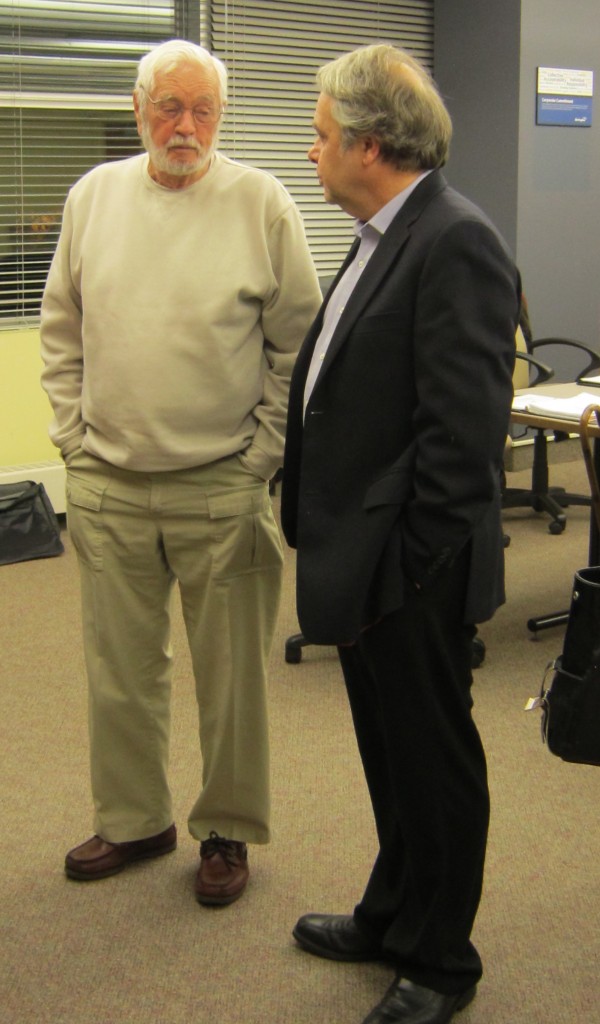 Les Armstrong on the left knows better than many people in the city what it was like when the railway line ran along the edge of the Lake west of Spencer Smith Park. Armstrong talks with James Smith, president of the FOFS and a former candidate for the ward 5 seat at the council table. Is he gearing up for another shot at that brass ring?
While it will sit on a site that is far from where the station will eventually rest – the longer term challenge is to get the station into Beachway Park alongside the old railway embankment where it truly belongs.
That will take some effort on the part of FOFS but they have shown this city council, and this city, that they can get things done.
Their fund-raising drive will start soon – be generous, it is your heritage you’re paying for. A city that has struggled with what it wants to keep and doesn’t want to keep in terms of buildings took a big step in the right direction last night.
For Burlington to have a Heritage Advisory Committee that is doing great work and to also have a citizens committee that stepped in when its city council couldn’t put one foot in front of the other without tripping – this is a good day for Burlington. Celebrate!
The Friends of Freeman Station will be at the Burlington Heritage Fair, on Saturday, Feb. 2 from 10 a.m. to 3 p.m. at Burlington Central Library, 2331 New Street. Visitors can see pictures of Freeman Station, get updates on the big move, and view train-related artifacts. Supporters can buy a T-shirt or print of the station, became a member and sign up for email updates.

 By Pepper Parr By Pepper Parr
BURLINGTON, ON. January 28, 2012 A city council committee took four hours two weeks to get to the point where they voted 4-2 to go ahead with a pilot project to collect data on just what having bicycle lanes on either side of Lakeshore Road from Seneca Avenue eastward to Guelph Line would do to the flow of traffic. That vote now has to be confirmed at a city council meeting tonight. It is expected to fail.
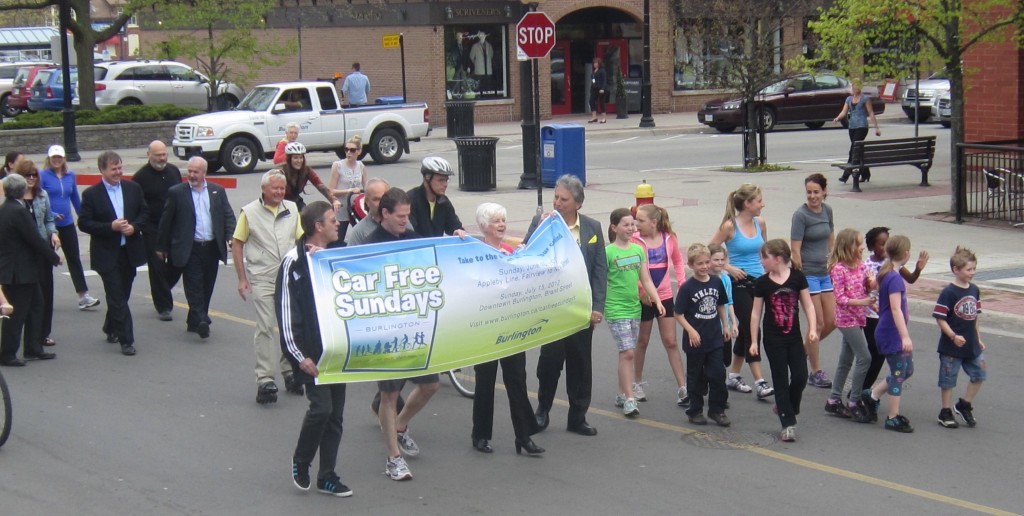 The public seemed to want Car Free Sundays so that bikes could take over the streets – but that same public doesn’t want the bikes in their own lanes on Lakeshore Road. Ward 4 Councillor Jack Dennison attended a public information meeting a few days later on the water main work that has to be done along Lakeshore Road before the lane markings get put in and said he expects to be tarred and feathered by the people he represents for supporting the pilot plan. He added that the Mayor is feeling the pressure. When asked if he thought the Mayor would hold, Dennison gave that look that suggested he too wondered if the Mayor would cave in to the pressure.
And there is pressure. The Mayor is being bombarded with emails and phone calls.
What the city doesn’t have is very much in the way of real, supportable data. What it does have is a lot of emotion.
I drove the stretch of road that is at issue – Lakeshore Road from Seneca Avenue to Guelph Line – and yes there was traffic but I had no problem making left hand turns into Seneca from Lakeshore nor did I have any problem making a left hand turn back onto Lakeshore from Delaware where I continued along Lakeshore and made a left north onto Green. I then drove along First went south on Beaver and made another left onto Lakeshore.
There was always oncoming traffic – but other than waiting – say maybe 10-15 seconds – I had no problem and there was never a back-up of traffic behind me when I was proceeding east on Lakeshore.
“When did you do this trial run”, I was asked. On Monday between 5:05 pm and 5:25 pm. “You went too early I was told”.
There are a lot of emotions about this issue but policy doesn’t get made based on emotions – does it?
The objective of the pilot is to determine if the changing of the size of the various traffic lanes on Lakeshore Road will affect people who live in the area adversely.
Three of the six council members are directly impacted by any changes to this road: Sharman, Meed Ward and Dennison. Meed Ward, whose Newsletter is the best of any council member, sets out why she voted against the change in lane markings. Her comments follow:
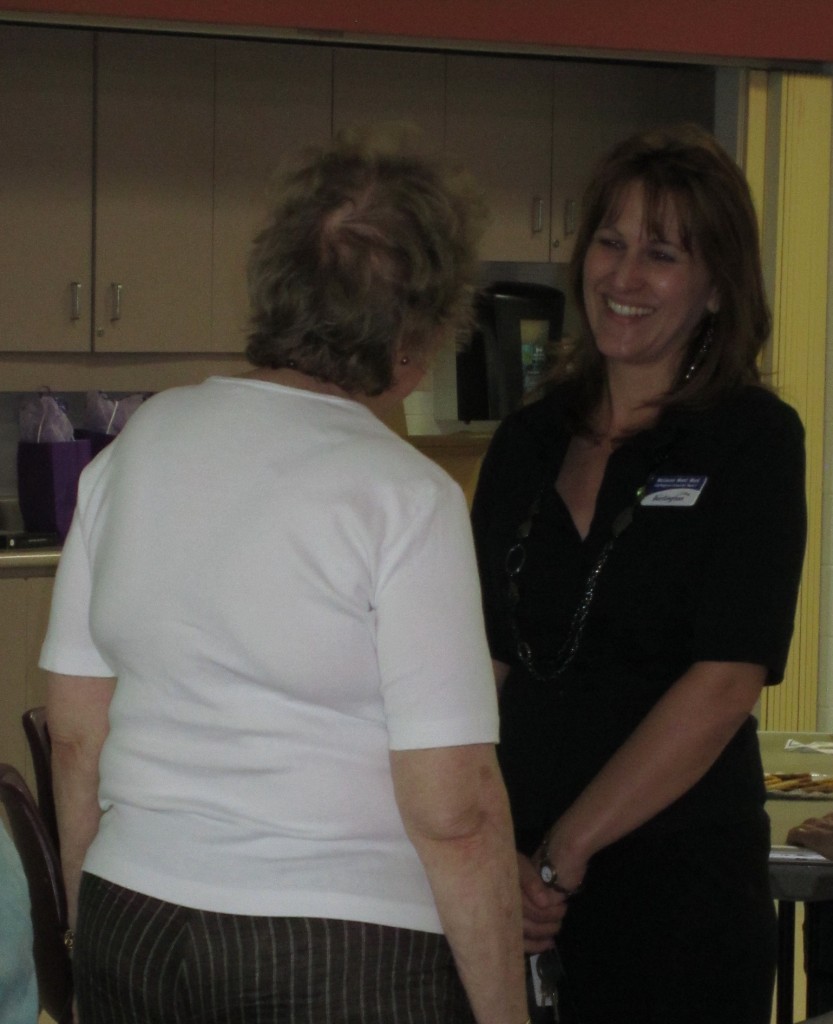 Councillor Meed Ward has always been good at listening – is the LAkeshore Road cycling issue an opportunity to lead? My Take: Along with my colleagues councillors Sharman and Taylor, I support retaining the current configuration of Lakeshore Road, primarily for safety reasons for all road users. Here are 10 reasons why we need to retain the centre lane on Lakeshore Road, and take steps that will actually deliver on the goal of helping residents to use cycling and active transportation.
1. The road is currently functioning safely.
Transportation staff have confirmed that the collision type and number are what you’d expect for an arterial road, and it is not listed on the Top 10 of problem roads in Burlington. In short, the road is safe for both drivers and cyclists.
2. Current cycling infrastructure in this area is adequate.
The Centennial bike path provides a safe, segregated and beautiful route for cyclists heading between downtown and the east of the city. In addition, there is the multi-use asphalt path on the South side of Lakeshore Rd. That path will be upgraded as part of the road reconstruction. A number of cyclists told council that for speed reasons they don’t like to use either Centennial path or the multi-use path, but the bottom line is that these services exist. No one is required to cycle on the road. Riders who feel safe on Lakeshore Road already cycle there without a bike path; those who don’t likely won’t cycle on Lakeshore Road even with a bike lane.
As an aside, the city is poised to invest heavily in cycling infrastructure – the proposed capital budget for 2013 includes $1.25m for new and upgraded multi-use paths throughout the city – we need to encourage cyclists to use these paths, rather than compromise road safety for everyone.
3. Changes to the road will compromise safety for both cyclists and drivers.
Residents on Lakeshore Road remember when the centre turn lane was installed for the safety of cars turning left onto and off of the road. They noticed fewer collisions after the centre turn lane was installed. I have asked Transportation Staff to provide that data (it should have been part of the initial report). Further, with just a narrow painted median for cars to wait while turning left, passing vehicles will veer into the cycling lane to pass, putting cyclists at risk.
4. Delays will result.
Traffic flow will be impeded by removing the centre turn lane, stealing precious minutes of time from families due to commuting, reducing their quality of life and adding further emissions to the air, affecting both drivers and cyclists. As one resident said in a letter to committee: “Should we not be concerned about the plan’s generation of so much idling traffic, with its resulting air pollution, in such close proximity to a public school and a dense residential area…There’s a Burlington by-law to stop vehicles idling for over 30 seconds; how many violations of that by-law will be directly caused by this plan?”
5. If you build it they will come only works in the movies.
We’re told that on-road bike lanes will increase the number of people cycling, but this vague hope fundamentally misunderstands why people don’t cycle now. It’s not because there is a lack of on-road bike lanes; it’s because more than half our residents must leave the city to work. Until we focus on economic development and bringing jobs to Burlington, cycling to work will remain a dream for our residents, even with on-road bike lanes. As one resident said in her letter to committee: “I like cycling myself. I cannot, however, find a way to bike my two children to daycare and then down to St. Catharines in order to do the job that pays my property taxes in Burlington….I have found biking over 100km a day to be especially trying in winter.”
6. There is no data to suggest on-road bike lanes will increase cycling in Burlington or has done so where bike lanes have been added.
Creating congestion and traffic delays as a means to get people out of their cars and onto bikes, without taking steps to rectify why people don’t cycle now, only produces…..congestion and delays. We need to balance the needs of all road users; this proposal creates significant safety and other negative impacts for the vast majority of current road users. It’s not balanced. Cyclists and cars are sharing the road well now.
7. Families won’t cycle on Lakeshore Road.
For many families and individuals on-road cycling is too dangerous even with on-road bike lanes. Our residents are looking for dedicated bike paths and separated bike lanes – Ottawa is a good example. This will take more planning and time – a precious commodity in an impatient world of instant gratification – but separated bike paths will go further to achieving the results we want.
8. The “pilot” has no goals to determine success (or failure).
The pilot will measure vehicle counts, travel time, bicycle counts and motor vehicle collisions, but no thought has been given to how many more cyclists will be required to deem the pilot a success, or how many accidents or delays are “acceptable” to deem this a success. Even one accident is too many – we should not be using our residents as guinea pigs to test the safety of the road. The lack of clear targets creates the impression that calling this a pilot is simply a device to push this through without proper data, consideration or due process.
9. Poor process leads to poor decisions.
This project has suffered from lack of good data and poor public consultation – being sprung on residents before Christmas, with a proposed amendment coming days before the final vote. There was no opportunity for a public meeting that would have provided an opportunity for table group discussion to learn from our residents what would help them pursue a more active lifestyle, and whether on-road cycling lanes on Lakeshore Road will have any impact at all on their cycling patterns.
10. We ignore the public at our peril.
More than 125 residents wrote to me and other members of council, to ask that the centre turn lane be retained. An additional 250 residents submitted a petition asking for the road to remain as is. Residents have clearly communicated their concerns, and goals for a balanced approach to cycling infrastructure. Yet those have been set aside. We’ve been told that supporting the on-road bike lanes at any cost to drivers and despite the concerns of residents, is showing “leadership.” Leadership has become the code word to justify ignoring public input.
The best decisions are made by carefully consulting and considering the views of the people most directly affected by our decisions. The city’s commitment to community engagement is built on this premise. It recognizes that elected officials don’t have a corner on wisdom (no one does), but that collectively there is much wisdom in our community if we listen and learn from each other.
When politicians dream about the future and impose a solution, it doesn’t always work out the way it’s supposed to, and residents are left suffering with the consequences until we fix it. One example will suffice: last week, council members discussed parking problems in the Uptown community of Burlington in Ward 5. This community was designed as high density with limited parking to “get people out of their cars” and onto transit. It didn’t work – people still have to drive outside the community for work, or long distances for shopping or recreation. So now Councillors are having to fix the situation, and have approved relaxed on-street parking rules in the area. Several councilors expressed surprise that the vision hadn’t worked. The reason: without jobs (and shopping and recreation) close by, residents still have to drive.
Making it hard for residents to drive doesn’t automatically get them out of their cars, if nothing else in the community changes. We need to heed this lesson before imposing hardship on the users of Lakeshore Road.
Meed Ward is not going to ignore her public – but she isn’t going to lead it either.
 The proposed pilot test of new lane markings on Lakeshore Road would run from Seneca (not Torrance) east to Guelph and have a very small divider lane with exclusive bike lanes on either side. Residents see that small divider lane as too small for them to make left hand turns. Dennison who is an avid cyclist, thinks the cycling lanes are part of the direction Lakeshore Road should be going in.
Sharman, who is also a consistent bicycle user and a strong proponent of the Car Free Sundays appear to be reacting to public pressure. For a guy who always wants the data he doesn’t seem too concerned about the lack of data on this issue.
The whole idea was to determine if putting bicycle lanes on either side of Lakeshore road would make any difference to the flow of traffic.
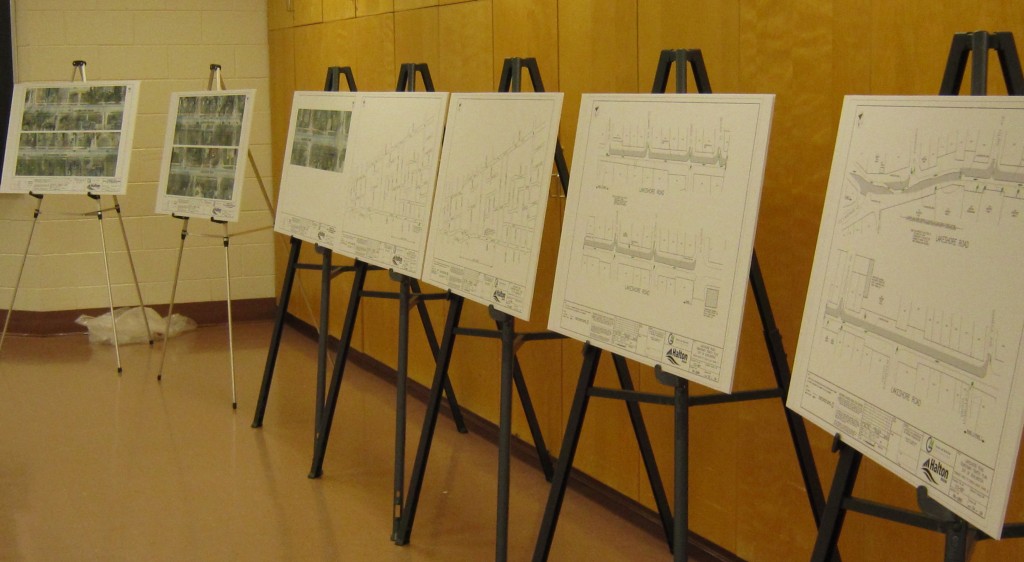 The Region ensured that the public got an opportunity to fully understand what was going to happen to Lakeshore Road when the water main was upgraded. The public was given useful data. Why can’t the public let the city gather useful data on what separate bike lanes would do to the flow of traffic on Lakeshore? Perhaps because emotions are over ruling reason? The road is going to get ripped up to have a new water main put in by the Region and no one is grousing about the problems that is going to cause. When the road is resurfaced after the water main has been installed the city wants to remark a section of the road and make provision for bike lanes that will stay in place from about September of this year until April of 2014.
What’s the big deal? If it becomes evident that the road cannot safely, and at little inconvenience to the people who live in the immediate area, handle the change in lane markings, then bike lanes should come out.
After driving about Lakeshore I headed north up Appleby Line to look at a parking problem in the Uptown area and then headed west along Upper Middle Road. If you want to have to handle traffic and struggle to make a left hand turn, with traffic lights to help – try Upper Middle. I wanted to go south on Walkers to get home. The traffic was backed up and it was going to take several lights before I would make it through the intersection.
I went further west to Centennial and was able to make a left and get home.
Upper Middle Road was a lot harder to drive than Lakeshore Road. And there were bike lanes which didn’t get in the way – but then it was cold, cold, cold and there was just the one brave cyclist on the road.
We have added some material from a city, Minneapolis, that has an active cycling policy in place. They have snow there and they have the coldest average temperature of any major metropolitan area in the United States.
The City of Minneapolis Bicycle Program is integrated into many divisions and departments at the city. The core staff of the Bicycle Program operates out of the Traffic & Parking Services Division of the Public Works Department. They have the primary responsibilities of educating the public through the Bike Walk Ambassador Program and implementing new projects through the Non-Motorized Transportation Pilot Program. Bicycle Program staff also produces the Minneapolis Bicycle Map and organizes the annual bicycle count. Other staff in Traffic & Parking Services responds to bicycle traffic safety issues and rents out bike lockers at municipal parking ramps in the downtown area.
Elsewhere in Public Works, new off-street bike trail projects, the bike rack cost share program, and the Bicycle Master Plan are managed by staff in the Transportation Planning & Engineering Division. Many Minneapolis bikeways are cared for by crews in the Street Maintenance & Repair Division.
In the Minneapolis Police Department, the Bicycle Recovery Unit stores recovered and abandoned bicycles and holds bicycle auctions. The Traffic Unit investigates accidents between bicyclists and motorists. The Traffic Control Unit enforces parking rules in bike lanes. Police officers in each of the five precincts enforce bicycle-related laws and respond to emergencies. Twenty-Eight percent of the MPD police force is certified to patrol by bicycle.
This is a city with a committed policy and pro-active programs that lead to, foster and support increased use of cycling.
Burlington has a Master Cycling Plan and does make attempts to promote cycling. The city held a Bike to Work day event at which breakfast was served for those who arrived at city hall on their bikes. The Mayor was there on the bike that seems reserved for just photo ops; he does not ride to work on a bicycle.
Cyclists have a right to be on every road in the city – not the 400 series roads but certainly on Lakeshore Road. They have a right to the safe use of those roads. Bike lanes will be safer. Will creating exclusive bike lanes make it safer for cyclists and not unduly delay car drivers – that’s what the six to nine month trial was being put in place to tell us.
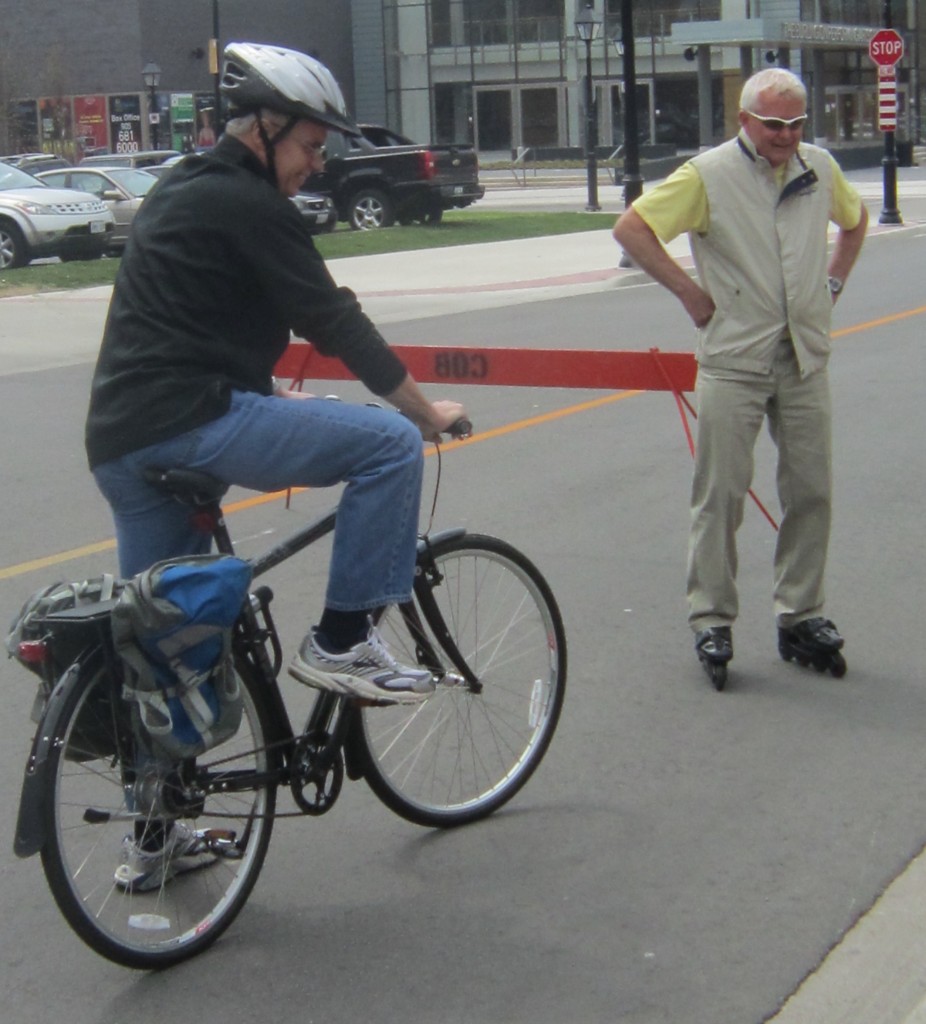 Will this Mayor on his bike ever get to ride on a separate and safe bike lane on the Lakeshore Road? Not if they Mayor folds at city council this evening. The cycle enthusiasts put forward some very solid data at the council committee meeting that deserves attention. Those opposed to the cycle lanes gave anecdotal evidence that had an obstetrician missing a birth because of traffic. Why didn’t he leave earlier; he certainly knew the road and its traffic patterns.
Councillor Sharman fanned useless flames when he spoke of the possibility of one of his constituents dying in an ambulance because it got tied up in traffic – such rubbish.
Mayor Goldring speaks glowingly of the cycle plans he saw in Portland, Oregon when he visited that city. The glow appears to have rubbed off – most indications are that the mayor is getting antsy about the vote for the pilot he cast at a council committee meeting.
Looks like we are in for a long city council meeting tonight.

 By Pepper Parr By Pepper Parr
The Halton Region Health Department is launching the first phase of Sex Healthy Halton; a social media campaign to promote safer sex, healthy relationships, raise awareness, and reduce sexually transmitted infections. There is aFacebook page
“The landscape for today’s youth is constantly changing and evolving and we need to ensure the youth are able to get trustworthy, reliable and accurate information and services,” stated Gary Carr, Halton Region Chair. “The Health Department’s approach to service and education is reflecting these changes.”
 Infections transmitted sexually are not just an uninformed teen problem – it`s n adult problem as well. The Facebook page is the first phase. A YouTube channel with videos of Public Health Nurses answering frequently asked questions and discussing current and local topics will be launched later this fall.
In Halton, Chlamydia rates increased 173 per cent between 2001 and 2010. In 2011, a total of 833 Chlamydia cases were reported compared to 454 cases in 2007. Social media and networking sites are quickly gaining popularity as a medium.
And that is all the Region tells you. We researched a bit and have added this:
What is chlamydia?
Chlamydia is a common sexually transmitted disease (STD) caused by a bacterium. Chlamydia can infect both men and women and can cause serious, permanent damage to a woman’s reproductive organs.
How common is chlamydia?
Chlamydia is the most frequently reported bacterial sexually transmitted infection in the United States. In 2011, 1,412,791 cases of chlamydia were reported to CDC from 50 states and the District of Columbia, but an estimated 2.8 million infections occur annually. A large number of cases are not reported because most people with chlamydia do not have symptoms and do not seek testing. Chlamydia is most common among young people. It is estimated that 1 in 15 sexually active females aged 14-19 years has chlamydia.
There is a lot more information the Region could have provided – are we sensing some timidity here?
“There are a lot of false information, myths and misconceptions about sexual health and sexuality,” stated Dr. Bob Nosal, Halton Region Medical Officer of Health. “We hope to provide a safe and trusted environment for youth to ask questions and seek answers. Social media will never replace one-to-one services or counseling, but this will open the door for discussions and education.”
Youth will be able to ask questions (publicly or privately), search for answers, connect with a Public Health Nurse, and find information about clinic locations, times and services.
You can follow-up on this: Dial 311 or call 1-866-442-5866.
There were just 13 likes on the Facebook this morning – we will track this and see if it is serving a useful purpose or if it is just one of those mickey mouse, tepid efforts that bureaucrats who don’t want to embarrass anyone tend to do.
A mistake made as a teenager alters a life forever and usually not just the life of the teen. Kids get it – we just need to inform them. This just might be one of the good ideas.

 By James Smith By James Smith
BURLINGTON, ON January 27, 2013 This is as Canadian as it gets – folks taking advantage of the cold to play shinny on the storm water retention pond on the north side of North Service Road just west of Guelph Line.
Coincidentally the same weekend as the start of the Last Burlington Winter Carnival.
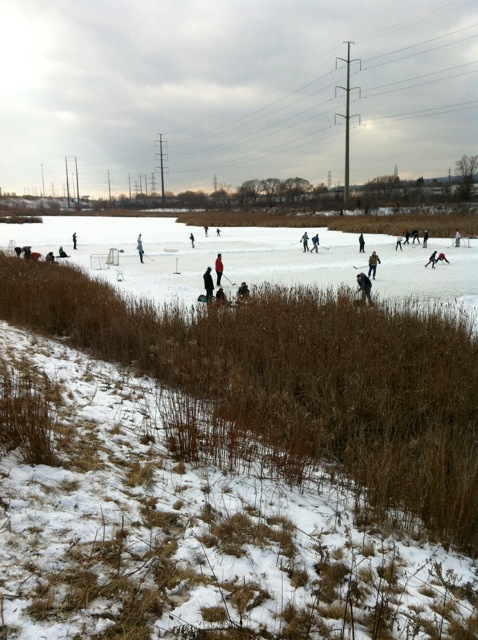 With a game being played on one ice pad parents remove surface snow for a second pad. Who said the Winter Games couldn’t be played this year? I loved finding wild ice and playing shinny or just going for a skate when was a kid in Montreal and Etobicoke. These games always seemed more satisfying than our organized hockey league games. When my kids were little, we made our way to the marsh in Bronte several times for this kind of skating fun.
One could say something cliché about how this is oh so Canadian, but heck, it really, really is!
There’s just something wonderful about people without a whole lot of planning taking advantage of an impromptu situation and making the most of it. These kids will remember this experience all their lives.
My only quibble is this is a busy stretch of roadway, & is a little dangerous, pity there’s no place to park other than the shoulder of the road. I do hope the City Parking Storm Troopers don’t get wind of this!

 By Pepper Parr By Pepper Parr
BURLINGTON, ON January 25, 2013 So – Sandra Pupatello wins – then what happens?
First there will be a by-election to get her a seat in the Legislature. Then the Legislature will resume and Pupatello will show the province just what she is made of. This woman is a tiger – she doesn’t take prisoners.
She will eventually get the election she wants and wipe the floor with Tim Hudak. She will go to the public with a strong set of candidates – what will that mean to Burlington?
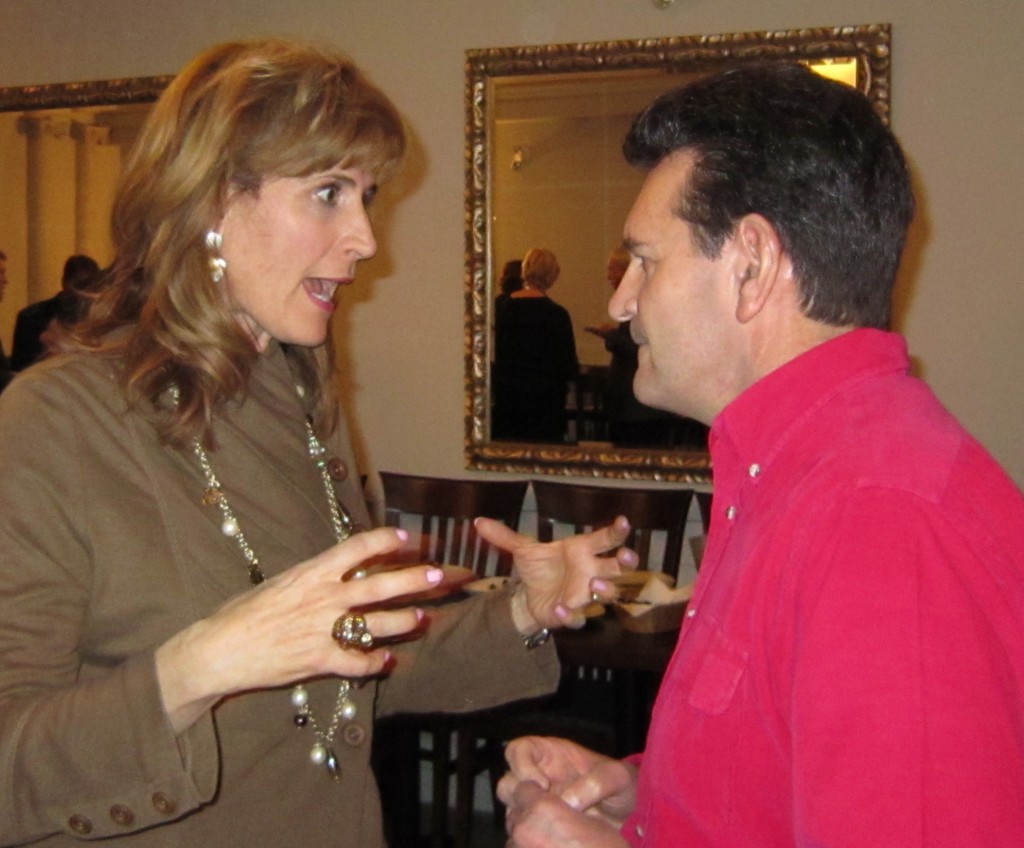 Provincial Liberal leadership delegate Sandra Pupatello meets Burlington’s Ward 1 Councillor Rick Craven. Could they work well together? Jane McKenna will want to brush up her resume. Burlington has two, maybe three potential candidates – one of whom can win the seat with a dynamic enough leader.
Ted McMeekin, the cabinet minister to the east of us and the go to guy when Burlington wants to be heard by the provincial government. He is supporting Kathleen Wynne because she might keep him in cabinet. Pupatello won’t invite McMeekin into the cabinet she forms.
There is an opportunity for McMeekin to run for Mayor of Hamilton – they will love him over there – but Mayor of the zoo on the other side of the Skyway may be more than McMeekin wants to take on.
Ted Chudleigh should hold his Halton seat which includes parts of northern Burlington . It would take someone who has done a lot of ground work to beat the man who knows his job, does his job and is well liked. He has high name recognition and there are no smears on his copy book.
Sandra for sure on Saturday – then let the games begin. Ontario has never seen a leader like this before.

 By Pepper Parr By Pepper Parr
BURLINGTON, ON January 24. 2013 It was back in 1986, when Roly Bird was Mayor of the city. At that time there was a regular Mayor’s Breakfast – an event that gave the wheelers and dealers and wanna be’s an opportunity to get together and network – they didn’t call it that then – it was just the way local politics was done.
Someone came up with the idea of having the Mayor give an annual address. They needed a name for it and decided they would model it after the State of the Nation address used in the United States. Burlington was keeping one step ahead of Oakville which still have Mayor’s Breakfasts.
Burlington has been doing this ever since. This morning, on a crisp Canadian winter day, more than 400 people drove out to the convention centre on Burloak, drove around looking for a parking spot and did what Roly Bird introduced them to back in ’86; get caught up on what’s happening at city hall.
These State of the City addresses gives the Mayor a chance to trot out the list of things that have been done – sort of like a shareholders meeting where all those holding preferred shares get to enjoy their dividend.
This event is put on by the Mayor; his office controls the flow and the event. No questions get asked and you’re given phrase after phrase of the kind of stuff only a public relations specialist can write.
On balance Burlington is in good shape. At some point the people at city hall are going to stop trotting out all the MoneySense magazine ratings. It is a fine city but we seem to have let ourselves be defined by our geography. The “gem” or the “jewel” of a waterfront (with a pier that is coming in at three times it original cost) and an Escarpment that makes the city both rural and suburban at the same time. The city is not yet at that point where it can say it is urban or urbane.
We now know that the property either side of the QEW is our Prosperity Corridor and we were assured that city council will approve the Official Plan and the rezoning that is going to be needed to get IKEA into the property it has optioned on the North Service Road.
Council will pass the changes to the Official Plan and give IKEA the rezoning it wants and it’s then a done deal, said the Mayor except for three words that are laden with possible very serious problems. Goldring mentioned “two other processes” that we must go through – the Regional government and the Conservation Authority.
Region because Walkers Line is a Regional Road that is nearing capacity and the Conservation Authority because of a creek that is on the eastern edge of the property.
While Burlington wants the IKEA move to happen – the Region isn’t as close to the issue and are not facing the same pressure. There are 1 million visits to IKEA now – making it the city’s biggest tourist attraction (which got the only laugh Goldring was going to get with this address). The new location is expecting to get 1.5 million visitors annually. Walkers Line in its current form cannot handle that traffic and the two lanes that make up the North Service Road certainly can’t handle the traffic going into the location.
THE QEW cannot be made narrower so is any width for the North Service Road going to come out of the land IKEA has optioned? The next problem then is the railway line at the north side of the property. Is IKEA’s hope to make their site wider?
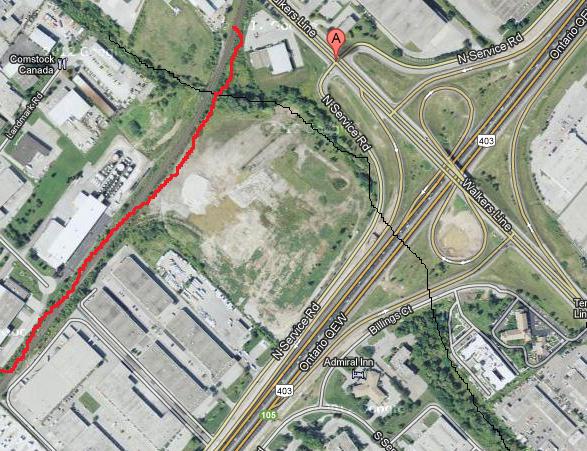 That red line is the railway tracks – the thin black line is the creek on the east of the property. Getting 1.5 million cars through the Walkers Line intersection is not going to be an easy transportation exercise. Mayor Goldring misleads when he doesn’t tell the full story. In the world of planning and design all is possible – but it is not easy and the Mayor misleads his audience when he says “two other processes” – when he should have said two bloody big hurdles that we don’t know quite how we are going to get over and if you’ve got any good ideas – give me a call.
The QEW is a provincial road so we are going to have to work closely with them
The Mayor then used some rather good public relations spin and turned this problem into what you are going to hear called THE PROSPERITY CORRIDOR which will stretch from Guelph Line to Appleby line on both sides of the QEW. That prosperity is going to amount to two million square feet of new office and industrial space and 6,000 high value jobs.
The Mayor talked about the role the IKEA project played in “helping us shape the new direction for the Burlington Economic Development Corporation” (BEDC). That was an impressive piece of public relations spin. The Mayor’s former Chief of Staff, Frank McKeown felt the best thing that could be done with the BEDC, which wasn’t performing all that well, was to “blow it up”.
There are some 20 people on the BEDC board. It looks like a federal cabinet that has to meet the demographics of a large diverse country. A board that size has people there to ensure that their interests are protected. The objective should be to get the smartest people you can find to do the job forget who they represent. Paul Subject, a member of the board, didn’t expect to have to jump into the fray when he put in more time than he expected working through the way the BEDC would re-shape itself to meet the very real problems it was facing.
The city hasn’t approved the budget that is going to be needed to re-shape the BEDC; the Mayor didn’t mention that one either.
The proof is always in the pudding – and this one is still in the pot. The people who do the thinking in this city are going to find themselves re-thinking and perhaps re-shaping the council that leads them. See that as a heads up.

 By Pepper Parr By Pepper Parr
BURLINGTON, ON January 24, 2013 Effective immediately, Halton residents can access neighbourhood-level crime incident data from the previous day, week, or month, or even search as far back as six months ago through a new crime mapping function that can be accessed through the Service’s website www.haltonpolice.ca.
“Providing reliable, timely crime data to the communities we serve is one of our top priorities, because an informed public is a safer public,” says Halton Chief of Police Steve Tanner. “This partnership with CrimeReports gives us the ability to keep the public informed on a regular basis as to what is going on in our community.”
Police dispatch data is stripped of personal information, including the exact address, and sent securely to CrimeReports.com, which hosts the crime mapping software. The public can access the data through the Service’s website, under the Crime Files/Mapping navigation button.
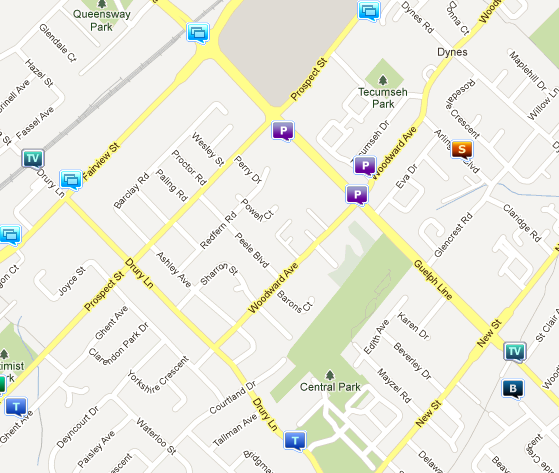 Each of the small coloured squares on the map indicates a crime – theft from an auto, a break and enter or an assault. Click on the graphic and you get some detail. Will you be safer with this information – probably not. Will you feel safer? Maybe – nice toy which we are paying for. Incidents reflected on the map will be shown within 100 numbers of the address, to protect individual’s privacy, while still being within the general vicinity to give people an accurate idea of crime in their neighbourhood.
The crime mapping data will include police-dispatched calls for property damage, sexual assault, assault, robbery, break and enter, theft, impaired driving, homicide, attempted murder, offensive weapons, drug-related offences, and various traffic-related offences such as impaired driving, hit and run, and motor vehicle injuries and fatalities.
“Information is power,” Chief Tanner added. “We hope that by giving the community this information, it will help them understand crime trends and better enable them to assist us in preventing crime in their neighbourhoods.”
The public can access the free crime data through the Service’s website or through the CrimeReports iPhone app, available for free download in the Apple iTunes store. The new service even lets local citizens sign up for free customizable email updates, so they can monitor crime in their neighborhood, or click to link to the CrimeStoppers of Halton website to file an anonymous crime tip.
The HRPS asks the public to keep a few things in mind when accessing the software:
• In order to access the data, people will need to first read and click a disclaimer
• It takes a few minutes for the map data to load, depending on your internet connection. Please be patient.
• Map data is based on dispatched calls, not completed investigations so therefore incident codes may change.
“Police are often dispatched to a call that initially may be reported as a one type of crime and later turn out to be unfounded or another type of crime. In such a case, the call will appear on the map as initially reported but later be removed or changed,” explained Chief Tanner. “The crime map data is as accurate as possible, but not 100% fool-proof given the evolving nature of police investigations.”
This looks like one of the ideas Chief Tanner brought with him from Kingston where he was the top cop before he came to Burlington.
LATER: Having read what the police had to say about the service I logged in – and sure enough there is a map with little squares in different colours that tell me the kind of offence that took place. There was a drug bust over on Inglehart – not too far from me and a theft from an auto on Walkers Line but nothing on my street.
So what does this service do to keep me safer? I guess knowing that there was a drug arrest on my street would let me know there is a dealer nearby if drugs are my recreation of choice or tell me that I can keep an eye out for “suspicious” behavior and call the police. Noticing that there were a number of auto break-ins in the area might get me to ensure that my car is locked before I bed down for the night.
And of course there is an App for this too – so I can keep up to date on crime on my street while on the GO train. Or – I can add even more to my overflowing email box and get a notice sent directly to me telling me what’s happening in the “hood”.
There is no mention of what the service is costing – it can’t be free but it sure is a whiz bag toy if there is nothing on TV – I guess.
Ain’t technology great?


BURLINGTON, ON
January 24th, 2013
Dear Sir:
In the beginning there was a plan for a partnership between the city, senior levels of government and interested citizens of the city to build a Performing Arts Centre and then have it operated by a separate and independent board. As years past the estimated cost of construction grew without any government commitment to maintain or increase their share of the costs. Private groups came forward saying they would hard to make up the difference but there were no tangible dollars put down.
As estimated costs grew without a plan to pay for them I wrote council and the Post about the financial peril of the project. Unfortunately dreams prevailed over facts and the project went ahead.
 Ward 4 resident Jim Barnett says: “The mayor now says this slow start-up is normal. If it is normal, then it would have been anticipated. It is abnormal, thus the city is being asked to bail the project out. It was not that long ago the city was touting the independent board that would make handouts unnecessary.” The business plan as presented never did have a realistic ramp up in revenues in the early years, but with out this incorrect forecast, the project might not have gone ahead. Therefore it was ignored and the praying started. Well the praying did not work and there is a substantial shortfall. Not only in 2013 but likely for some years to come.
The mayor now says this slow start-up is normal. If it is normal, then it would have been anticipated. It is abnormal, thus the city is being asked to bail the project out. It was not that long ago the city was touting the independent board that would make handouts unnecessary.
Having to hire two more people at this time again points out the flaws in the plan to date.
Let us all remember that only a small cross-section of the citizens use the facility.
When all costs are in, the pier will exceed $20 million and you will not be getting anything back in insurance.
I fear that Performing Arts Centre will also become a drain on the city’s resources, making plans for the hospital more difficult, and increasing taxes for the people who do not use the facility.
Unfortunately I do not have a solution. I hope someone can come forward with a way to save the project and prevent another embarrassment for the city.
In the meantime, I hope the city going forward gets out of the business of building structures that they do not know how construct, finance, budget or manage.
Jim Barnett
Letters to the Editor are welcome. Please include a telephone number at which you can be reached. We qualify each submission. Include illustrations if you wish.

 By Staff By Staff
BURLINGTON, ON January 24, 2013 Mayor Rick Goldring delivered his third State of the City address to a sold out audience at the Burlington Convention Centre:
Good morning Ladies and Gentlemen and thank you for taking time from your busy schedules to attend this year’s State of the City Address. This is my third address and it is something I look forward to every year.
Before I go any further, there are several people I want to thank and acknowledge. The Chamber of Commerce for not only hosting today’s event, but for your relentless efforts in advocating for business and increased prosperity in Burlington.
 Throughout the first half of this his first term as Mayor, Rick Goldring has been out in the community talking and listening; doing what a Mayor us supposed to do. I would like to thank today’s sponsors – Scotia Bank, Bell, Certified Management Accountants and The Centre for Skills Development & Training. Events like these would not be possible without the support of our valued community sponsors.
I also want to thank TVCogeco for broadcasting this address to those who cannot attend in person or are here today but want a repeat viewing. An informed community is an engaged community.
I would also like to thank and introduce my Council colleagues: Councillors Rick Craven, Marianne Meed Ward, John Taylor, Jack Dennison, Paul Sharman, and Blair Lancaster. Of the many achievements we have accomplished, what I value the most from you is the professionalism, dedication, and collaboration you bring day in and day out. While differences of opinion arise from time to time, as they do and must in great councils, the interests of our constituents’ and the City always remain first and foremost. I can honestly say this Council is focused on and committed to the tasks at hand and the people of Burlington. Burlington is a fine example of the effectiveness of municipal government.
City management and staff – we are proud and fortunate to have a fine team that serves the needs of our community, often without fanfare or notice. You are the backbone of our daily lives, making sure that the vital, in-demand services you provide each day are done professionally, efficiently, and with our customers in mind. I would like to introduce two of our three senior executive teams – both Jeff Fielding, City Manager and Kim Phillips, General Manager of Community Services are with us this morning.
And to the people of Burlington: it is truly an honour and privilege to serve you.
This year’s State of the City Address is a time to review our performance and share our upcoming priorities and opportunities. It is a measurable and transparent scorecard, which reflects three core themes that are important to this council: strong governance, accountability, and community aspirations.
This morning’s address is divided into three areas:
1. 2012 in Review
2. Looking Ahead: 2013 and Beyond
3. The Long Term Vision for the Future
2012 in Review
As we all know, the global economy remains seriously challenged. With escalating debt levels and an uncertain economic horizon, governments around the world, at all levels, are challenged in maintaining highly valued, if not essential services, despite an ever straining tax base. Burlington is not immune to these head winds.
But as we also know, Canada has, to date, been able to weather through these difficult times better than most countries. With Burlington’s location, talent and creativity, we have forged a road ahead, on our own terms, accomplishing impressive wins for our community.
I will go through the key highlights of 2012 now, but if you want details, please refer to report we are releasing today: “The Sum of 2012”which is available here and on the city’s website.
I invite you to view it at your leisure to see all the great and tireless work being done by so many in our great city. I want to thank the city manager’s offices, our communications department and my staff for their hard work.
Burlington’s robust economy continued to grow in 2012.
• 680 new full-time jobs and 220 new businesses were created.
• Our unemployment rate is at 6.0%, which remains lower than the provincial average of 7.8%.
• In 2012, Burlington issued 2,138 building permits having a construction value of over $425 million.
• The office vacancy rate has fallen to 10.5% from significantly higher levels only a few years ago.
• More businesses are either coming or expanding in Burlington. The industrial vacancy rate is down to 5.5%, a low mark.
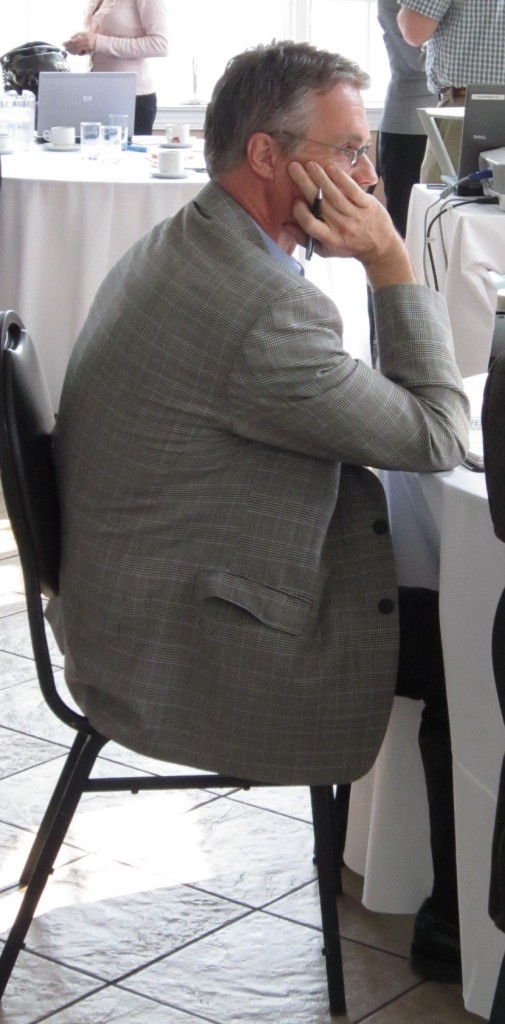 Meeting after meeting listening, making comments and doing what a Mayor is supposed to do I am pleased to advise that the re-development of Joseph Brant Memorial Hospital is on track. The contribution agreement for the City’s $60 million was finalized last year. City staff are currently working on the site plan application for Phase 1 of the project and we expect this part of the process to be completed relatively soon.
I am very pleased to advise that meaningful progress has been made on the Brant Street Pier in 2012. Work has continued in the winter and staff expect the ribbon to be cut in June.
As you know, the City of Burlington and Halton Region strongly opposed the expansion of the Nelson Quarry, which is nestled on the Niagara Escarpment in a designated UNESCO Biosphere Reserve. A Joint Board decision that undeniably supported our position was reached in October.
Prior to becoming Mayor, I identified the need to review our Downtown plans and get back on track. Council established a downtown task force early in the term to update these plans, which incorporate the waterfront, and we continue to receive feedback from across the City. On November 6, a Downtown Vision Workshop was held at the Burlington Art Centre and I was inspired by the number and energy of the participants, who shared their vision and ideas. The key findings from this summit will form an important component of our Official Plan Review.
Back in 2011, I determined that local graduates were not finding career opportunities in Burlington. I was concerned about losing our best and brightest. Determined to change that, innovateBurlington was created along with several community partners. I’m pleased to report that innovateBurlington has been a huge success with:
• 10 graduates participating in the program this first year;
• 5 alumni now working locally in their field;
• Revenue targets were exceeded and innovateBurlington worked with 12 companies and completed 13 projects;
• 16 mentors provided guidance and experience to our grads.
innovateBurlington is a great example of how we integrate opportunities for local youth employment and the needs of the local business community, and provides us with our future community leaders.
Responsible governments have to be fiscally prudent. 2012 offered unique challenges in the constant battle to weigh the inevitable trade-offs between increasing taxes and tailoring services and responsibilities. We have managed this well, despite the challenges.
Council agreed to an increase in the hospital tax levy of 1% in 2012 and the expectation at this stage is that we will do the same for 2013 and 2014. The community has told us loud and clear that the Joseph Brant Memorial Hospital redevelopment is a number one priority. The community needs to get behind the foundation as they work to raise their $60 million share for the redevelopment.
For 2011 and 2012, there was a cumulative increase of 3.2% for the Burlington portion of property taxes or 4.2% including the increase in the hospital levy. Our objective in the longer term is to maintain average tax rate increases around inflationary levels, which is very challenging to achieve.
What does all this mean?
MoneySense magazine named Burlington the GTA’s number 1 city and the second best city in Canada in which to live. It was also rated the 8th best place for jobs.
In an independent survey this past Fall conducted by Environics, Burlington residents who were surveyed responded:
• They were very satisfied with the services they receive from the City of Burlington
• 83% of Burlington residents surveyed said they receive excellent value for their tax dollars
• Burlingtonians are very satisfied with municipal government.
• Residents also have a positive outlook on the future as it pertains to both their quality of life and personal financial situation.
• 95% say they have an excellent or good quality of life.
Our 2012 efforts and results will go a long way towards Burlington continuing to be a destination and home for families and businesses. The challenge going forward will be to maintain this positive progress and energy, and build on this foundation and drive.
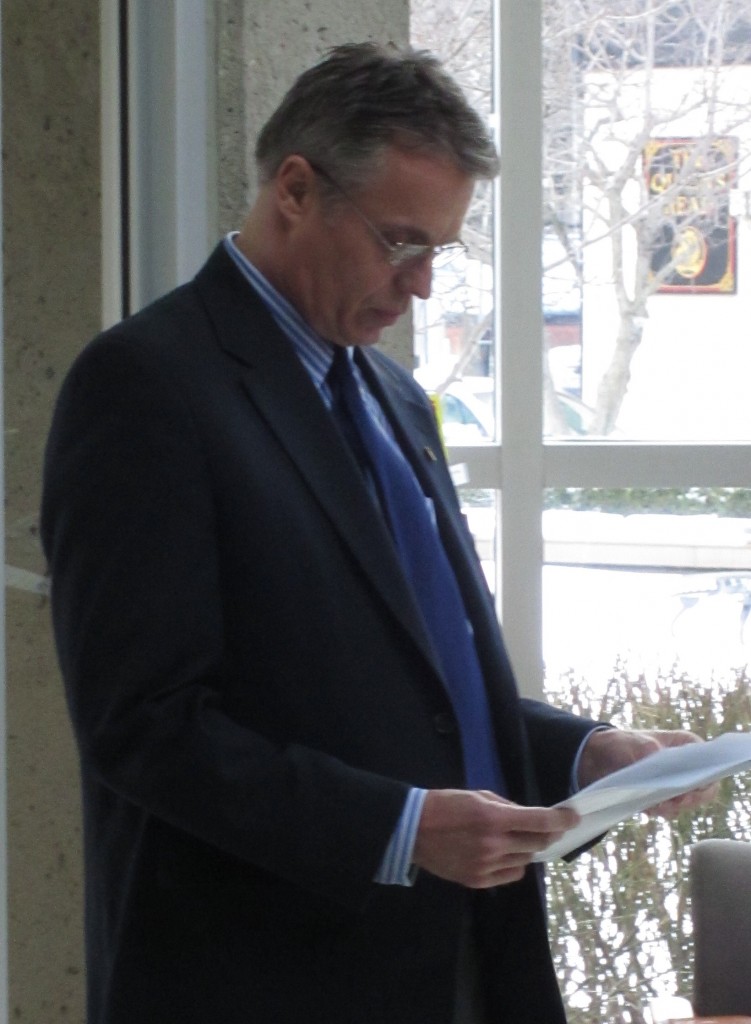 Mayor Goldring delivers his speeches in a direct deliberate style. Last month, at a presentation hosted by the Burlington Economic Development Corporation (BEDC), Craig Wright, Chief Economist at TD Bank and Burlington resident, suggested that Canadian growth would be dampened and kept at about the 2% level, interest rates will likely remain low and the regional housing market will cool, with little risk of a major declines. Craig then moved to his view of the local Burlington economy and clearly stated that we have a “vibrant local economy that is well positioned to grow.” As evidence, he cited the diversity of our economic base, noting the healthy mix of professional services and manufacturing in Burlington and the fact that we are a relatively prosperous community; our household incomes are nearly 20% higher than the Ontario average. This will sustain the local housing market and fuel future growth in consumer spending to the advantage of local businesses.
Canadian businesses have improved balance sheets, indicating a future acceleration of their respective investment levels. This means to me that we need to ensure Burlington is well positioned to capture more than “our fair share” of such future investment.
We must position and market ourselves accordingly, with the right infrastructure in place. Burlington must be fiscally responsible and well-run; an engaging place that businesses are attracted to and invest in and where their people want to live because of the amenities and quality of life we offer and enjoy. This is our key challenge for 2013 and beyond.
Looking Ahead: 2013 and Beyond
So what must we get right in 2013?
The Pier construction must continue to be well-managed by our staff. This project has been a visible distraction to all of us. Once completed, the pier will integrate positively into our iconic waterfront and provide an identity for future generations.
Last year several parks were completed in North Burlington and our new state-of-the-art Alton Public Library and Community Centre, built-in conjunction with a new public high school, will be open this fall. Knowing that access to parks and green space are important drivers of citizen satisfaction and quality of life, we are investing in our communities and creating vibrant neighbourhoods.
We are working with our neighbours in Hamilton on mutually important issues through the Greater Bay Area Sub-Committee. This includes the clean-up of Randle Reef and potential economic development opportunities, which will open the door for future, mutually beneficial partnerships.
Our Official Plan Review will continue in 2013. This is an extremely important process because our population is changing and there is very little room left for brand new greenfield development. Within our Alton community, there is only potential for 450 more single family homes. Our present and future state is infill, intensification and redevelopment that provide us the opportunity to create compact, mixed use and walkable neighbourhoods.
We also have a growing number of seniors and single person households. The needs for housing, transit, and services will also change. The Official Plan Review will be a big picture look at how and where we will grow from here, to meet our needs and create the Burlington of the future.
A number of important strategic initiatives took place in 2012 where we will see results this year.
Our Community Energy Plan team will submit their report, allowing us to set and achieve long-term sustainability goals. Together with Halton Region, we are working towards the development of the Beachway Park Master Plan with recommended actions in 2013.
Late last year, the province advised us that they will be addressing transportation challenges in the Halton, Hamilton, Niagara regions by widening existing highways and not with a brand new Niagara GTA highway through North Burlington-for now. The details will be announced in February.
Widened highways will not address the issue long-term. Commute times in the GTA are some of the longest in North America. We need the province to aggressively support “The Big Move” plan of Metrolinx. This requires $50 billion of funding of which only $16 billion of that has been funded. If implemented, the result will be a 32 minute reduction in average commute times in the GTA.
With the fiscal challenges of the provincial government, they have to look at alternative sources of revenue to pay for this which could include road tolls, parking levies, a regional sales tax or increases in the gas tax. The federal government needs to step up as well, as Canada is one of the few countries in the world where the federal government does not contribute to public transit. There is no time to wait on this, as the cost of congestion is significant for both commuters and consumers.
Led by our City Manager, Jeff Fielding, staff has initiated Results Based Accountability, with a goal to have Performance Based Budgeting in place for 2015. We will continue to realign our programs and services to meet the goals and objectives of this Council’s Strategic Plan. This includes continuing with a head count freeze at City Hall. All new positions required are filled by redeployment of existing staff or attrition.
The City’s e-government technology project is underway with the goal to significantly advance our web-based customer service.
One of the key priorities for 2013 will be the Burlington Economic Development Corporation. In November 2012, Burlington City Council endorsed aggressive growth targets and formally requested the BEDC to take a more direct, active and strategic role in the short and long-term development and marketing of Burlington.
While the city’s employment lands are valuable strategic assets, they are in limited supply. We must take a proactive and targeted approach to preserve and optimize the city’s employment land inventory to yield higher tax contributions bringing in proportionally more revenue and making us less reliant on residential property taxes. The longer term goal will see the City essentially double its industrial/commercial revenues over 20 years by focusing on business intensification below the escarpment, thereby driving Burlington’s long-term fiscal capabilities and sustainability.
Looking Ahead: Beyond 2013
Burlington is at an interesting point in its history. We are becoming built out as mentioned earlier, resulting in our tax assessment growing at a slower rate. We are aging at a rate greater than provincial averages with 17% of residents over age 65, and 45% over 45. The major revenue source for the City is from property taxes. Now more than ever, we need to be creative in looking at our financial situation in the long-term and analyzing our balance sheet, which could result in the redeployment or leveraging of our assets. We cannot accept status quo thinking.
As Mayor, I am part of the Large Urban Mayors Caucus of Ontario (LUMCO). One of the areas we are focusing on is research in preparation of asking the provincial government for the opportunity to access alternative sources of revenue. There is real unfairness about a tax system that sees municipalities receiving 11% of tax revenue generated along with maintaining 65% of the capital infrastructure. Mississauga Mayor Hazel
McCallion has said many times that the federal government has all the money, the province has all the power and the municipalities have all the problems.
So what must we get right in the long-term?
We must redefine and market Burlington’s value proposition to target global and national companies in key economic sectors including advanced manufacturing, financial services and information technology.
We must review the City’s planning and development approvals system to be more in tune to the needs of industry and business and create a distinct, sustainable competitive advantage.
An early example of this is the Ikea project, which played a vital role in helping us shape the new direction for the Burlington Economic Development Corporation, by creating the opportunity for big picture thinking about the needs for our future growth and development to retain and attract the kind of businesses we want for Burlington.
I am pleased to announce that at our next Council meeting, we will be approving an Official Plan Amendment and Rezoning Application to allow for the relocation of Ikea to the QEW and Walkers Line. While there are two other processes that we must go through with the Region, Conservation Halton and the Ministry of Transportation, I am confident that we will be successful in keeping Ikea’s Canadian head office here in Burlington. What does this mean for Burlington?
• A new head office and store over 440,000 square feet, which is 70% larger than the existing facility;
• about 90 new jobs or nearly a 20% increase to their team;
• $1.7 million in total tax revenue and $10.8 million in total development charges;
• a facility that attracts about 1.5 million visitors to Burlington.
IKEA has become the catalyst for unlocking the development potential of the North Service Road area.
Developing the area of North Service Road between Guelph Line and Appleby Line is the starting point for turning the QEW employment lands into Burlington’s Prosperity Corridor.
Our vision is to launch a cycle of re-investment that will see high-profile sites fill the QEW corridor with new office buildings that will house companies and create high quality jobs that mirror the skills of our residents. This will be an opportunity to leverage our investment in the DeGroote of School Business with the prosperity corridor. This will be a significant development of over 2 million square feet of new industrial/office development projects and will accommodate over 6,000 new high-value jobs.
Another element in the development of our employment lands to create jobs and prosperity for the city is the redevelopment of the King Road Underpass, also known as the ‘Big Push.’ This significant engineering accomplishment marks the kind of strategic and innovative investments that will continue to take us into the 22nd century.
Our goal is to build over 900,000 square feet of new industrial/commercial facilities every year which will generate over $600,000 in new ICI tax revenue; and create 1,526 jobs per year for a total of approximately 29,000 new jobs across the city by 2031. This will increase the opportunity for more residents to not only live in Burlington, but work here as well, improving their quality of life.
Burlington’s era of automatic pilot growth and new construction is over. We are out of land for large new residential subdivisions and our supply of industrial/commercial land is also constrained. So, I repeat the earlier question, “what must we get right in 2013 and beyond?”
When Wayne Gretzky played hockey, he saw and played the game in a very different way. He never worried about where the puck was at any given moment. Everyone else did. He stayed steps head, thinking where the puck is going to be and then acted. We have to anticipate and shape our future and then act, ahead of, smarter, and better than others.
If civic government was merely the fiscal administration and execution of specific services, this would be simple and clear. But I propose that civic leadership is more than that. As stewards for our community, we must harness and galvanize the energies and desires of our people, community groups, and businesses to make Burlington the choice where people want to dream, live, enjoy, work, raise their families, and invest, now and in the future.
To do this, we have to dare to create a clear, unified vision, designed and executed by all stakeholders, and then drive to put and maintain Burlington on the map of top-tier communities. We have to envision and create our future on our own terms.
Two months ago, I arranged for an Inspire Burlington – Defining Our Dream workshop for 35 community leaders including representatives from Council, business, media, education, community groups, faith, sports, arts and culture, healthcare, youth and environmental advocacy groups, to define the dream for Burlington.
The objective of the two-day workshop was to define an exciting future or dream that we can all aspire to, work towards, and benefit from. The two days were both invigorating and exhausting. The depth of people’s passion for Burlington was phenomenal and authentic. There were three major themes that came out of the workshop.
Burlington is a compassionate, connected community. This is evidenced by the work of our social agencies, faith communities and service clubs that reach out to those in need including the 17,000 people in Burlington living below the poverty line.
There is a tremendous connection with our natural environment. In fact, the terms “Iconic Natural Identity”, “Jewel on the Lake” and “Sense of Place” were used. While the Niagara Escarpment is not unique to Burlington, it is integral to our City.
The other theme encompasses “Super Charging Ideas” which recognizes that with our limited growth potential and the way the world is changing, we need to be innovative and creative using “22nd century thinking” to maintain and enhance the vibrant nature of Burlington, where we are the home of “great opportunities” with “local riches and “global impact” being created.
Burlington offers so much: wonderful neighbourhoods, a great waterfront, our rural north, great parks and open space, recreational and cultural opportunities, great businesses and educational institutions. If you can’t find what you need in Burlington, you don’t have to go very far to find what you are looking for.
Why do people choose to live in Burlington or have their business in Burlington? It is quality of life. I mentioned earlier that 95% of the people surveyed by Environics rank their quality of life very high. Our challenge will be to maintain what we have.
This, for me, was an amazing process – both inspirational and educational. For us as a collective, it solidified the direction of our strategic plan and reinforced the work we have begun at the City. I believe, ultimately, that the information gleaned during this process can become a blueprint for all of our stakeholders and partners to use in planning for their future. It can give us an intelligent, pragmatic, and sustainable competitive advantage and serve as our legacy to future generations. As a community, we must shape and drive our future together.
So what do I want you to take away from today?
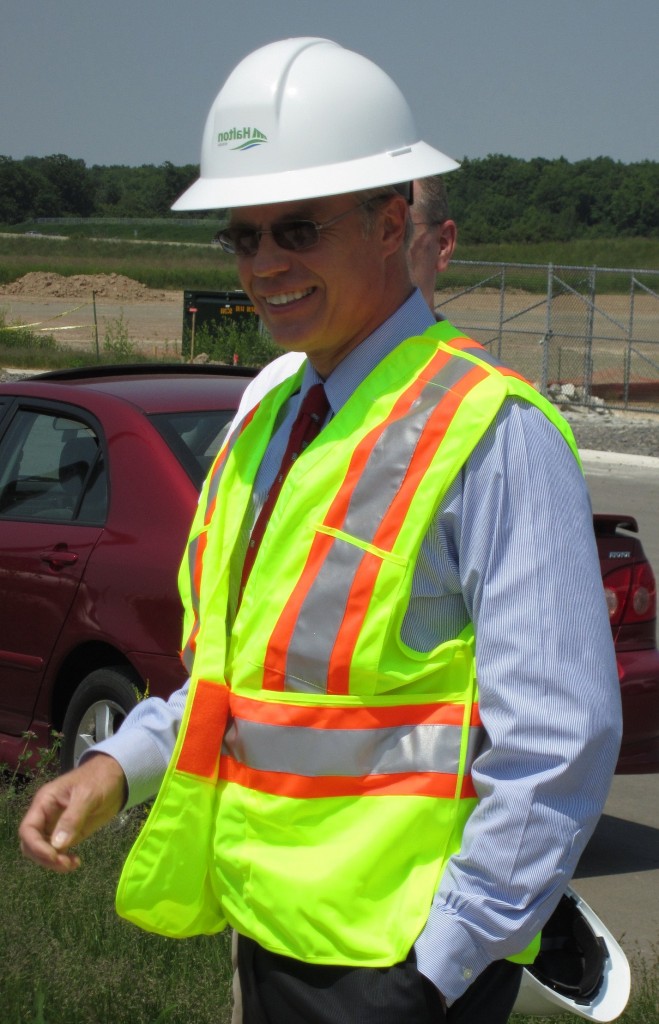 Opening new parks, cutting ribbons – all part of the job a Mayor does. Be positive. Burlington is in good shape. Council is committed to keep Burlington as a thriving, prosperous, inclusive community through strong fiscal management, innovation and partnerships.
Be open to change. We have a meaningful Strategic Plan in place with a focused Council and staff that understands Burlington’s priorities. We will continue to look at how we engage the community as we work through the change that is taking place. The City of Burlington is focused on improving customer service, improving productivity through technology, and decision-making through teamwork and performance based measurement.
We will overcome challenges and continue to position ourselves as the community of choice for residents and business because of our strengths, amenities, and quality of life. We will not take anything for granted.
What makes me optimistic for our future? Burlington is a not just a city. We are a community; a community of partnerships, and generosity. A community of people who strengthen this city giving it its character and charm, who balance pride with humility, with neighbours working together and otherwise people from different walks of life, who selflessly and quietly help others. I am continually inspired by the efforts of the many people who do caring things for others in our community.
It’s the single volunteer who cooks a turkey for Christmas dinner at Carpenter Hospice, to those who contribute precious dollars and talent to community groups, all the way up to the rather astounding force of the Burlington Eagles Hockey Club who along with other organizations, collected more than 200,000 pounds of food in their Fall Food Drive for local food banks.
We have a past and present that we can be rightfully proud of. But what excites me, what inspires me, is the enduring spirit of our community and people.
So let’s dream and join together, for Burlington and each other. We are in this together. And together we will continue to build a wonderful city.
Thank You.

 By Staff By Staff
BURLINGTON, ON January 24, 2013 While hockey is the sport that drives our passion – winter is what really makes us Canadians. To get outdoors when there is snow and just plain play is a large part of what this country is all about. The Lowville Winter Games take place this Sunday from 11:00 am until 4:00 pm. There is plenty to keep you active, interested and busy and outdoors with snow on the ground.
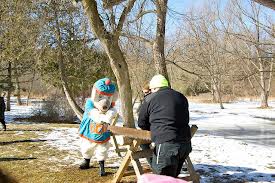 Getting the hang of how to use a cross-cut saw on a cold winter day – part of the Lowville Winter Games. There is a log sawing contest – if the city’s fireman show up they could take this one.
There will be Horse drawn wagon rides.
 Not sure quite who is having the most fun here – but hot chocolate is going to go down well after this tumble. It looks like there has been enough snow and it certainly has been cold enough for the snow to stay which means tobogganing.
Winter weather and outdoor activity means tummy’s that want filling; frequently.
 Now if this child could be as focused while doing homework – but this is the Lowville Winter Games – that marshmallow comes first. The Lowville Bistro will be operating full tilt; the United Church will be holding a BBQ and the Gorilla Cheese Truck will be on hand as well.
The Body Zorbs Race Track, the Human Gyroscope and craft by Momstown are part of the day’s events
Conservation Halton will be putting on a Birds of Prey Show.

 By Pepper Parr By Pepper Parr
BURLINGTON, ON. January 24, 2013 It was early in the term of this city council. She forced a recorded vote on six different items knowing full well when she asked for the vote that she was going to lose every one of them. Her fellow council members rolled their eyes and went through the exercise.
While very little of the brashness has left Meed Ward, she is wiser than she was that first year and has her ear to the ground not only in her ward but across the city.
She has major issues with the close to $1 million the Burlington Performing Arts Centre is asking the city to cough up. Part of the money is to cover the $225,250 short fall from last year’s operations and some additional money to hire additional staff, which Meed Ward feels is using the solutions that haven’t worked in the past to solve problems before the BPAC staff now.
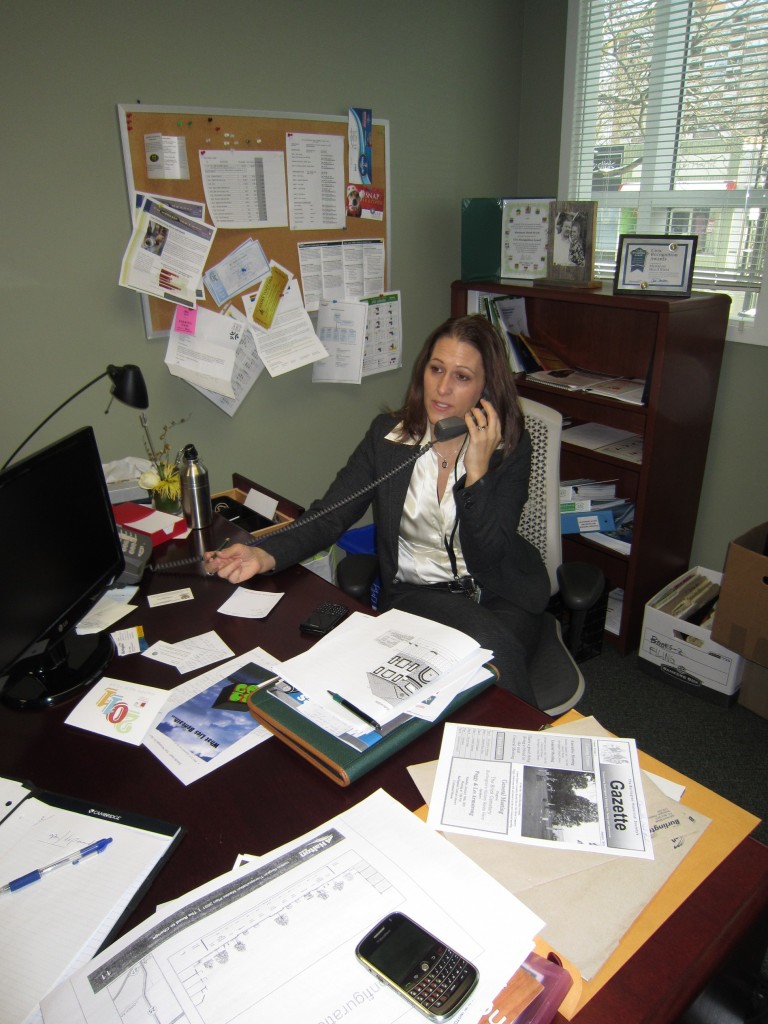 Meed Ward at her old city hall office – the desk is as cluttered in her new space where she tends to fill up her voice mail box and overspend her postage allowance. She promises to get back to people within 24 hours – and delivers on that promise. Now she wants to deliver on her promise to keep spending in line with what is in the bank. Meed Ward doesn’t think public money should go into making up the losses on commercial acts that didn’t pay for themselves. Those losses should come out of the reserve BPAC has suggests Meed Ward, who believes the city can and should provide funds that will go towards helping community groups use of the space. One of the problems community groups have is the cost of the facility while they are doing their set up; they haven’t had to deal with those costs in the past. Meed Ward thinks the city can provide an amount BPAC would make available to community groups as a sort of set up subsidy.
In our conversation with Meed Ward, whose position on the ask for increased funding is well-known, we asked: What do you do?
“Tough question” she responded. “I am wondering if the people in place now have the expertise to get the programing right – and it is about programming. Do the people running the programming side know Burlington’s culture well enough to be able to discern what the community wants” is one question Meed Ward asks.
“Are the price points for the commercial entertainment what this community can pay? Is the programming mix right? Meed Ward wants to see data on what the attendance has been and where the people attending these events come from. “Are we serving our market or are we drawing people from other communities?”, asked Meed Ward.
Meed Ward admits that the task of running a cultural operation in its second year is a challenge and says the solution can’t be to keep coming to the city for more money: “ If the skills needed to program the place are not at hand, then we need to find those skills elsewhere”.
Meed Ward’s issues however are not just with staff. She feels the Burlington Theatre Board has let everyone in the city down and tells of an experience she had with the hospital board where she serves as the city representative.
“There was a meeting at which the hospital Board was discussing the agreement the hospital had entered into with the city related to the $60 million Burlington is putting up for the hospital re-build.
Meed Ward, who doesn’t know what a “small measure” is, was ready to get right into the discussion. You can’t take part in this one she was advised – you sit on city council and ‘you have a conflict of interest’ she was told.
You can imagine how Meed Ward took to that comment – but the chair discussed it with legal counsel and the decision of the chair was that Meed Ward did have a conflict. “I didn’t agree with the decision but I respected the view of the chair and left the meeting.”
“There were no hard feelings because of the decision. The chair had a view he was able to substantiate and I respected the chair; that’s what governance is all about.”
Meed Ward discussed the situation with Mayor Goldring who agreed that Meed Ward had a conflict. He understood the position the hospital board chair had taken.
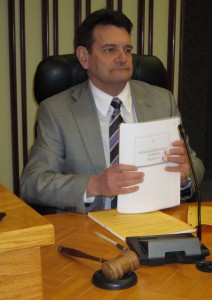 Ward 1 Councillor Rick Craven – half of what Councilor Meed Wards describes as the Rick and Rick” team – who she thinks have a conflict of interest over the BPAC budget they approved as members of that board and now want to vote on at city council 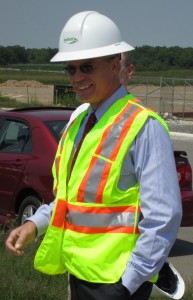 Mayor Goldring – the second part of the `Rick and Rick`team that Councillor Meed Ward thinks may have a conflict of interest on the BPAC ask for close to a million dollars this year. Meed Ward now wants “Rick and Rick” which is how she describes the Mayor and Ward 1 Councillor Rick Craven, to be just as mindful as she has had to be. “They can’t sit on the BPAC board and agree with the budget they want to put forward and then attend a city council and note vote for that budget at city council. They have a conflict and Meed Ward is waiting to see if they will step outside.
Her view is that the Theatre Board doesn’t operate quite as professionally; that they see themselves as a group of people who go along with each other to get along with each other – and that Meed Ward will quickly tell you is not what Board members are in place to do.
They are there to ask the hard questions on behalf of the community and Meed Ward doesn’t see that happening. The Board is supposed to ask the tough questions and give tough directions.
Meed Ward doesn’t see very much, if any, cooperation between the Burlington Art Centre and the BPAC people. Ian Ross, Executive Director of the Art Centre is, according to Meed Ward “one of those guys that can think out of the box.” There isn’t much in the way of a working relationship between Ross and Brenda Heatherington, Executive Director of BPAC. The two are in the cultural business, selling what they have to the same audience and many feel there should be both a close bond between the two of them.
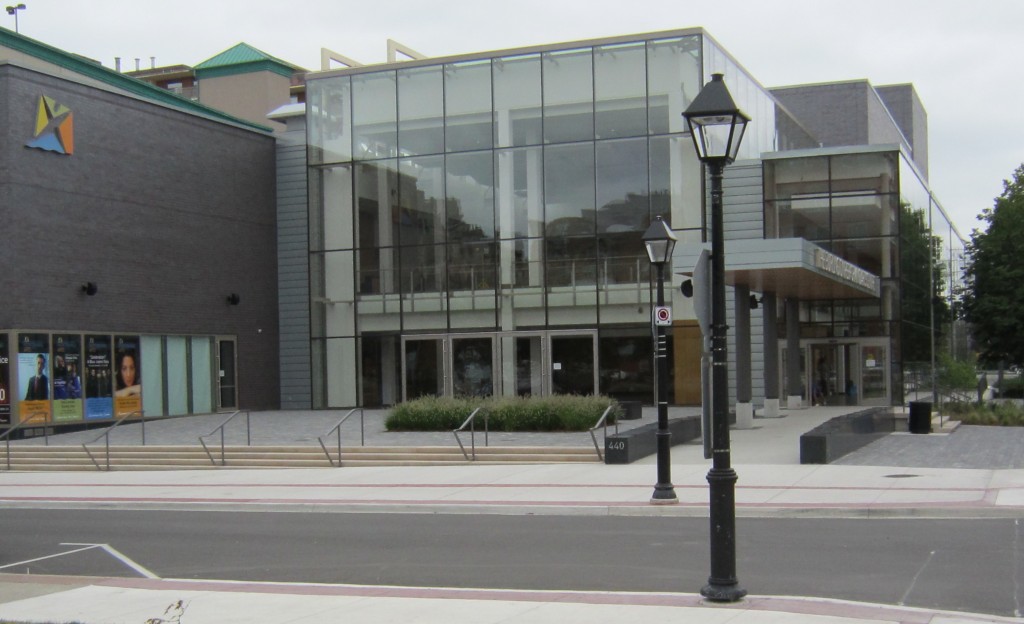 Ward 2 Councillor Meed Ward thinks the people working to make the Performing Arts centre work need to remember that part of the purpose was to create a space for local cultural groups and not to subsidize commercial acts. Meed Ward, whose ward takes in most of the downtown core believes there should be a group of people responsible for creating that cultural centre that is the BPAC and the BAC and to some degree the RBG and the Museum. “There is a need for all these people to collaborate and create that sense of a district:, said Meed Ward. She doesn’t believe that is happening and wonders if Ross and Heatherington have gotten together for as much as a cup of coffee.
And where is Tourism Burlington in all this? They put out the literature and market the city – do they do this in concert with the major cultural institutions in the city or do they hustle for just RibFest and the Sound of Music /
One wonders if anyone has suggested that the two boards, BPAC and BAC, meet together to share experiences and ideas and look for ways to share resources. Marketing is marketing and getting people to attend a performance or to take in an art show is fundamentally the same, so why aren’t the two looking for synergies and savings? When they fund raise they are both looking for the same deep pockets – could they collaborate and have a donour split a donation between the two organizations?
The BAC wants an additional staff member as well – Meed Ward says they should work with what they have. The city has committed to not adding any staff in the 2013 draft budget. “If the city can hold the line – then the local boards can do it too,” said Meed Ward.

 By Staff By Staff
BURLINGTON, ON January 22, 2013 Regional chair Gary Carr is very big on telling people he wants to hear what they have to say and he usually takes what he hears into consideration when he makes decisions. What Gary Carr rarely does it “rock the boat”. It just isn’t in the man – even though there are some regional issues that could use a tougher stand.
The Regional Chair is the person who can and should go up against the province on behalf of all the municipalities in the Region – that doesn’t happen often enough.
A significant number of the roads in each municipality are considered Regional roads. There is a new water main going in along Lakeshore Road in Burlington that is going to disrupt traffic and while local residents will call their local council member – it’s a regional issue over which the city has no control.
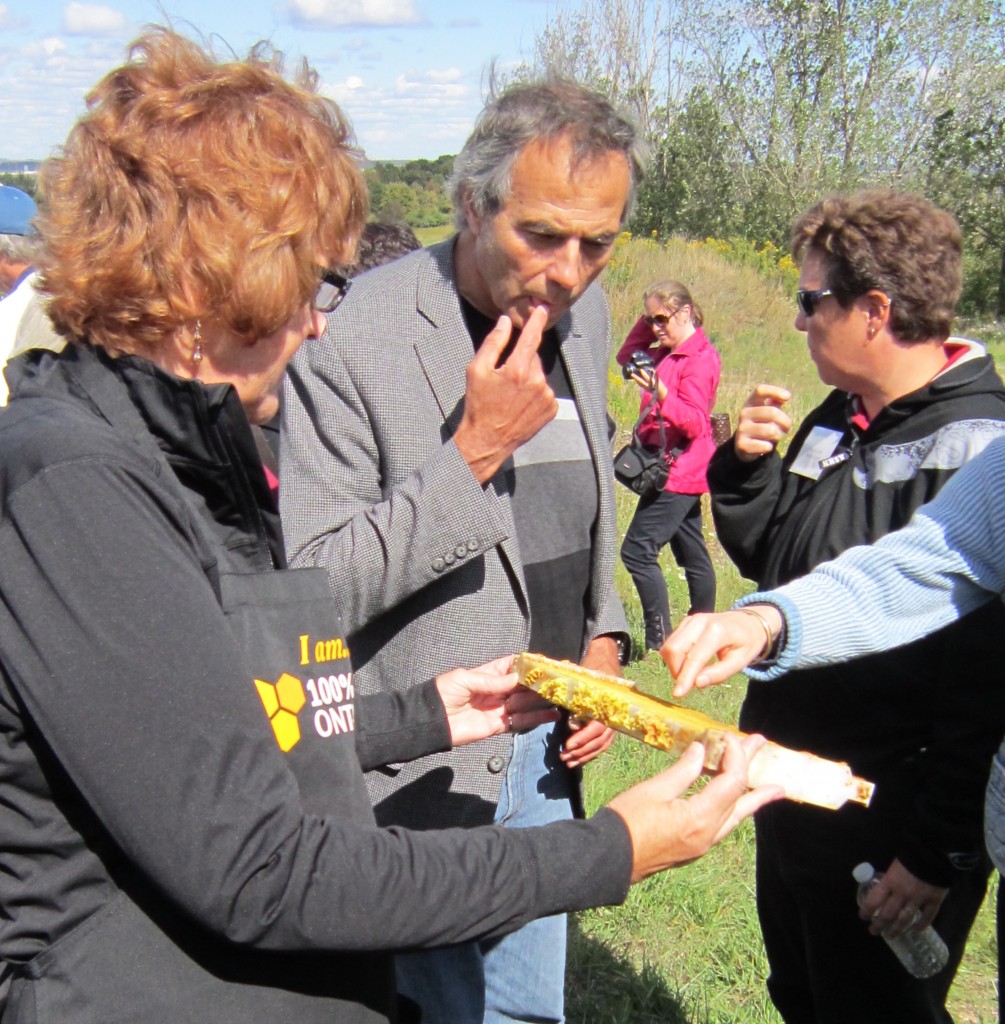 Regional chair Gary Carr tastes some raw honey while on a farm tour. The sweet spot for all politicians is getting people to talk to them, which the Region hopes you might do by giving them your point of view. There are other construction projects taking place – work along Dundas is another example, and the Region wants to know if you’re happy (content is another word they might use) with the way information is being conveyed to you.
At the end of the month the region is going to release a new survey to evaluate the effectiveness of its communications efforts in support of regional infrastructure planning and construction projects.
The survey is part of the ongoing Halton MVP (myViewPoint) survey series that asks an online panel of Halton residents for input on Regional programs and services. The survey results will be used to improve the Building a Better Halton communications program.
“Construction affects all of us in Halton Region,” said Regional Chair Gary Carr. “Our goal is to provide residents, businesses and commuters with useful and timely information that will help reduce the impact of Regional construction on drive times and daily life throughout the region.”
 Part of communicating with the people who pay the bills is sharing information. The Region is replacing a water main on Lakeshore Road east of the downtown core that is going to curtail traffic during the summer months. The Region requires the contractor to get out into the community with charts and pictures showing what is being done and how it is being done. To take part in Halton MVP surveys, residents must join the survey panel and complete a demographic questionnaire. Panelists may be invited to participate in up to eight surveys each year on a variety of Regional programs and services.
Registration is open to all residents of Halton Region (excluding employees of Halton Region) 18 years of age or older. To register, or for more information about Halton MVP, visit www.halton.ca/MVP.
To participate in the next survey on construction communications, eligible Halton residents must join the MVP panel by Sunday, January 27, 2013.
The Halton MVP survey panel is managed and administered by Jane Armstrong Research Associates on behalf of Halton Region through a secure website. All correspondence, data collection and data analysis are the responsibility of Armstrong Research. The names of panelists, or any other identifiable information, will not be released without written permission by the participant. Individual views will remain anonymous and data will always be analyzed and presented to Halton Region in the aggregate.
With the technology now available, governments can reach out and ask questions and get a sense of what people think and feel about something the government wants to do. It’s good governance and it’s very good politics – and if Regional Chair Gary Carr is anything – he is a very astute politician.

 By Pepper Parr By Pepper Parr
BURLINGTON, ON January 17, 2013 Parking in the community east of Appleby Line and north of Mainway is impossible. The houses were not designed for the parking that residents now need. The garages are too small for most cars and driveways are not all that big which for residents in the community amounts to parking tickets.
The real world of the people in this community is experiencing a very hard bump into the city’s three hour parking limit on city streets, which has been in place for 20 years. And it is hurting.
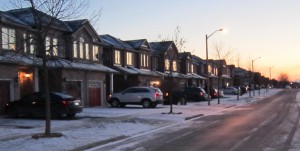 Looks OK on this side of the street. Relief is possible and Councillor Paul Sharman pushed through a Staff Direction asking the city staff to provide a report council can vote on at their end of the month meeting allowing the people in the community to decide if they want on-street overnight parking.
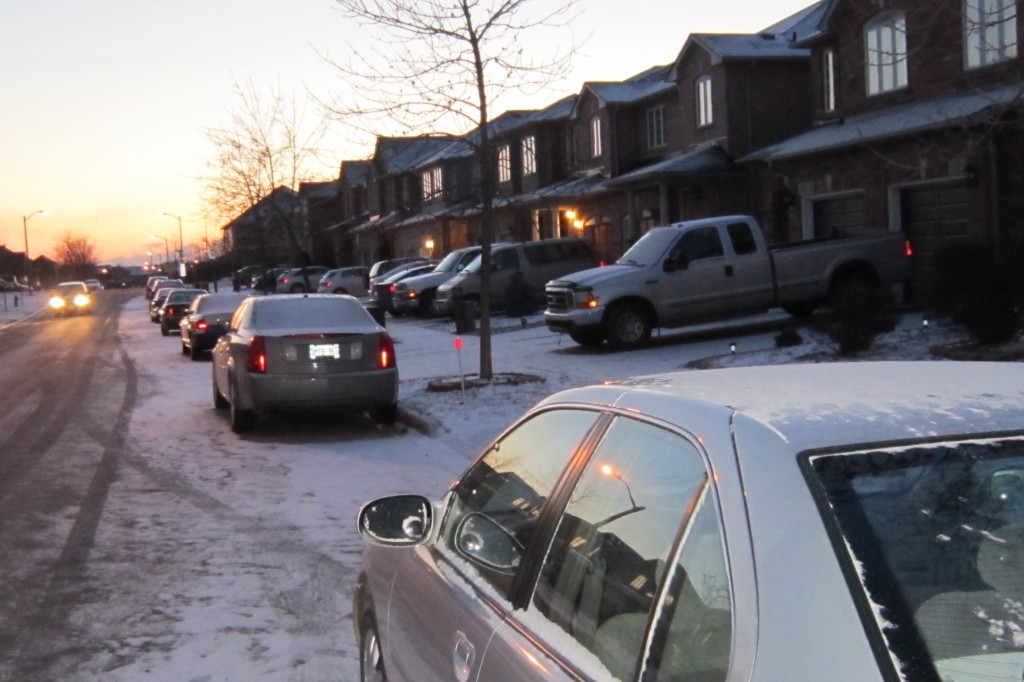 The story isn’t the same on this side of the street.
The city has what they call the NOSPP Neighbourhood On-Street Parking Program that allows a neighbourhood to petition city hall to allow overnight parking.
What does the City have in place now?
The existing 3-hour Parking By-law will still apply on a city-wide basis, excluding specifically the areas that are approved to participate in the NOSPP. The City will continue its current practice of accommodating specific needs of residents.
The Neighbourhood On-Street Parking Program (NOSPP) will let residents park on the street in front of residents homes for extended periods of time (either weekends only or 7 days/week, 24 hours/day or overnight from 1 a.m. to 6 a.m.) The policy was approved on a city-wide basis by Council on January 15, 2001, amended on May 20, 2003.
The NOSPP allows a minimum group of 10 residents (both sides of the street) or an entire street block to apply for extended on-street parking. The required criteria to qualify for NOSPP are outlined below:
Any “parking zone” within the City may apply for extended on-street parking by obtaining a package from Parking Services. A minimum of 75% support must be achieved within the designated parking zone in order to qualify.
There are several categories:
Category 1 – Weekends Only: To allow visitor parking over the weekend, for longer than the standard 3-hour parking limit. Automatically qualify for Weekend Parking if the NOSPP criteria are met, permitted times are between Friday at 6:00 p.m. and Sunday at 12:00 a.m. (midnight).
Category 2 – 7 days/week, 24 hours/day: To accommodate residents who are faced with inadequate off-street parking facilities. Must demonstrate to staff that inadequate off-street parking facilities exist. By definition, the term “inadequate” refers to 1 or less spaces designated for off-street parking.
Category 3 – Overnight: To allow overnight parking, from 1 a.m. to 6 a.m. daily. Must demonstrate to staff that inadequate off-street parking facilities exist. By definition, the term “inadequate” refers to 1 or less spaces designated for off-street parking.
Existing Residential Parking Regulations govern over this program; for example you may not park in a currently posted “No Parking” or “No Stopping” zone or within 3 metres (10′) of a fire hydrant;
Long term on-street parking will only be permitted on local and collector residential streets;
The NOSPP is in effect from January 1st to December 31st, however, no vehicles shall be parked in the designated NOSPP zone during winter control activities. To ensure efficient snow removal, all vehicles must be accommodated off-street until such time the street has been cleared of snow. Under the provisions of Uniform Traffic By-law 1984-1, as amended, any vehicles found to be parked in the designated zone during these activities will be subject to tagging and/or towing of the vehicle(s) at the owner(s) expense
Residents must pay the cost to manufacture, install and maintain appropriate signage. A one-time fee of $200 will be charged, which may be apportioned amongst participants. This fee must be received prior to the City issuing the work order to have the signs installed. The City will be responsible for the ongoing maintenance of any signs after installed;
Traffic flow must be maintained at all times.
The NOSPP is available for one side of the street only (and vehicles must still park facing the proper direction of travel). Parked vehicles are not permitted to block driveways.
Should removal of the NOSPP zone be requested at a later date, the same homes must be re-surveyed, and a minimum of 75% of those homes must be in support of the removal.
On-street parking spaces within the approved areas are not reserved and shall be used on a first-come, first-served basis.
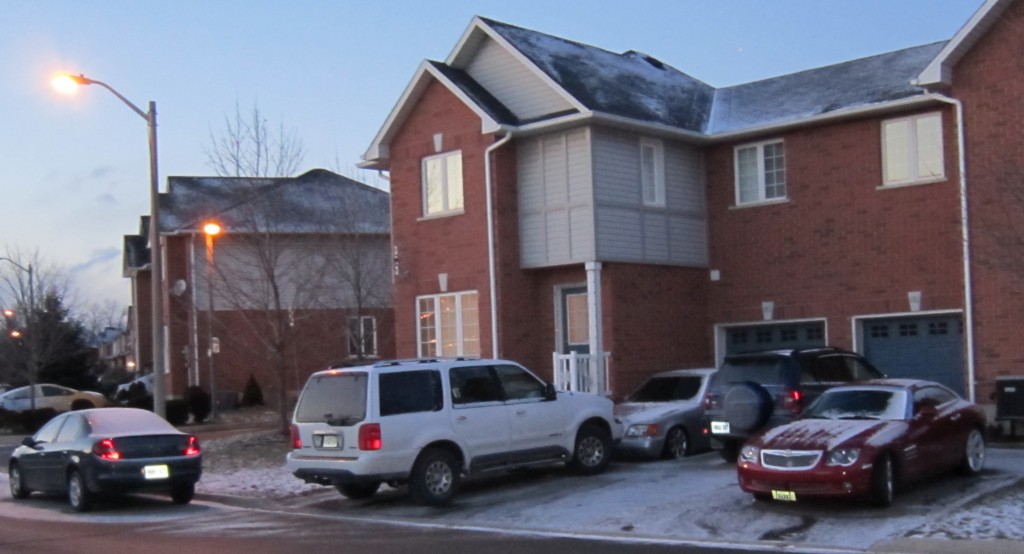 Garages for these homes are too small for the cars. Planning might have dropped the ball when the project was approved. That doesn’t do anything for the people in the community east of Appleby Line and north of Mainway where parking tickets have become a way of life. The 7 day/week, 24 hour/day option is not designed to provide extended on-street parking for households with more than 2 vehicles, or to promote the use of available garage space as storage. The purpose of this option is to allocate on-street parking to those who genuinely require it, as they lack adequate off-street parking facilities.
Sharman has been dealing with constituent complaints on this problem ever since he was elected to office. He just might have found a way to solve a problem for some of his resident.
Resident can get additional information at city hall – 905-335-7600 Ext 7560
Best to wait until this has cleared the city council meeting on January 28th – then you will need to talk to your neighbours and get them to sign the petition requesting the on street parking option.

 By Pepper Parr By Pepper Parr
BURLINGTON, ON. January 21, 2013 They were all there. Those that farm the rural part of Burlington; those people that live in the community and don’t want to see all that much change. The stop the Escarpment highway people weren’t out in force but they were there as well. The politicians that work the territory were in the room. And loads of staff people
The meeting took place in the elementary school in Kilbride and was part of the public process in figuring out how our Official Plan should be changed.
Every city in the province has an Official Plan that it must revise every five years. Some of the reviews are a “lick and a promise” and Burlington has had a few of those but this time out the city wanted to do some digging and begin asking the taxpayers just what they wanted their city to look like in 25 years.
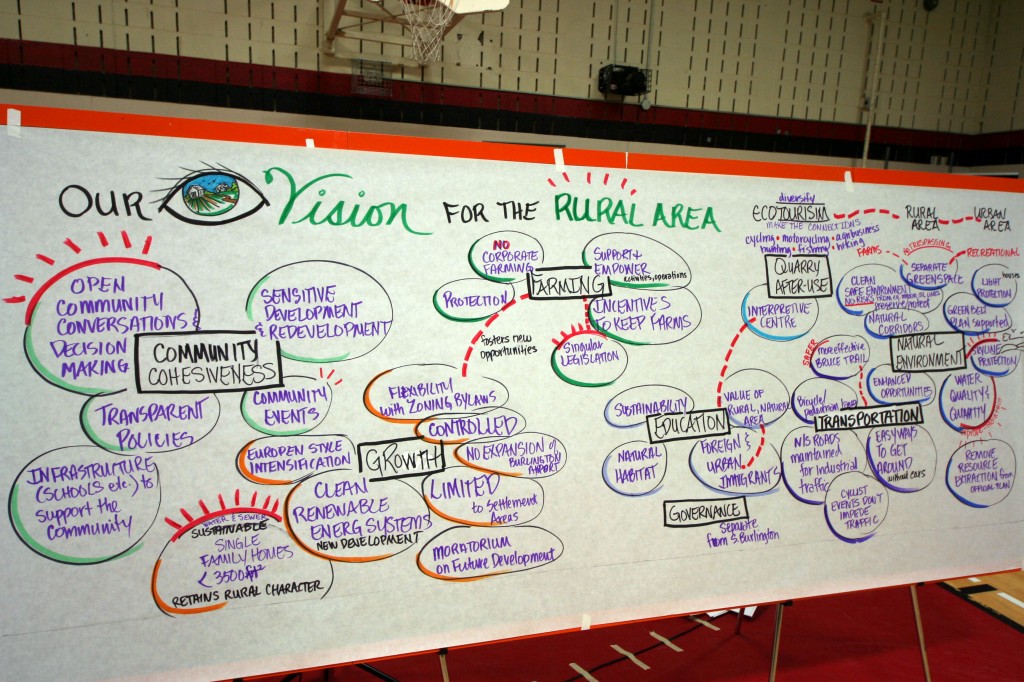 The vision for Rural Burlington as captured by a facilitator during the Rural Summit that took place at Kilbride Elementary school. Burlington is that odd combination of a well-developed suburban community with small patches of urbaness to it and then a large swath of land to the north that is rural. There are farmers up there that actually earn a living from the land they work.
There are no dairy herds; the last of the all-purpose farms went some time ago but there are people who take off quality hay and the equestrian sector is active. Strawberry farms do a decent business as well. But there really isn’t a farming community and while many people talk about reviving that part of the economy it is not likely to happen in rural Burlington.
What is happening is the development of large properties with houses that have in excess of 5,000 square feet and both indoor and outdoor swimming pools. Some of these properties are built on 15, 25 and 40 acres properties with a portion of the land taxed as residential housing and the rest taxed as farm land – with the land rented out to local farmers who are quite content to take hay off land that they rent. No long term investment and rents that are quite reasonable.
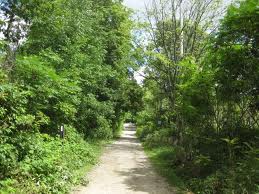 This is the rural Burlington residents want to keep – walking trails and quiet countryside. There is a farm on the north side of Dundas that thousands of people drive by weekly without knowing there is a pear farm up there with trees that are more than 100 years old.
For those who live in north Burlington there is always the sense that the lifestyle is being threatened. There are property owners with holdings on the north side of 407/Dundas who fully expect to sell out to a developer. There are people in the Burlington Economic Development office who see opportunities to develop the north side of 407.
The Region says that isn’t going to happen and the province says it can’t happen – but things change and over time many believe that they will see encroachments on what are now rural lands.
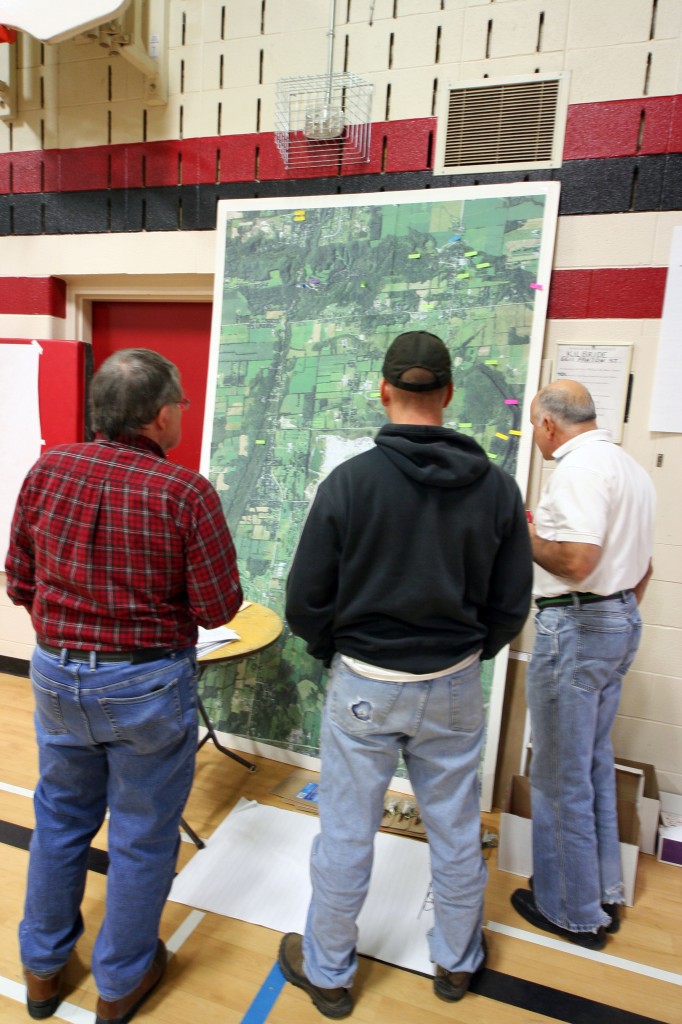 This is what rural Burlington is all about – large fields, small farms and people wanting to maintain a lifestyle. The boundary between suburban and rural used to be Dundas Street – the Old Hwy 5. When the 407 got built that boundary shifted and we saw the Alton Village community develop.
While any Niagara to GTA road is certainly on hold for now – the province has been consistently thinking about where a road can be built to handle all the traffic that wants to get to Windsor and Niagara Falls to cross into the United States.
The bulk of what Ontario produces get shipped to the United States and much of what we consume comes from the United States and heads into that huge GTA market. To get to and from that American market trucks need roads and the QEW has just about reached its peak.
The people who do the long term economic development thinking look at the Escarpment and think they could run a road through that part of Burlington.
John Taylor who is the biggest asset the city has when it comes to fighting for rural Burlington has taken the position that what comes out of the province in terms of policy doesn’t have to become the law of the land. He firmly believes that the public can talk back and points to the success with the application to enlarge the Nelson quarry – that application was denied and while the wish on the part of the aggregate people to be able to dig out rock and ship it to Toronto hasn’t had a dagger put through its heart yet – the chances of Burlington ever seeing another quarry developed on the Escarpment are very, very slim.
What the city and the Region – include the province in that – have to do is determine just what they want to do with the existing quarry once it is mined out. There are a number of long term opportunities here that the rural community can get behind and be very proactive in determining how their community evolves.
Last Saturday some 125 people met and talked; they made notes and exchanged ideas under the guidance of a good facilitator. What she didn’t do – and many wished she had done was ask people to identify themselves – if not by name then by where they lived. It helps when one has a context into which they can put the remarks being made.
One woman wanted the community to both empower the agricultural sector and support what they want to do. The sense I got from listening was that the agriculture community doesn’t have a vision other than to be left alone. There wasn’t any comment from anyone who identified themselves as a farmer – even though there were quite a few of them in the room.
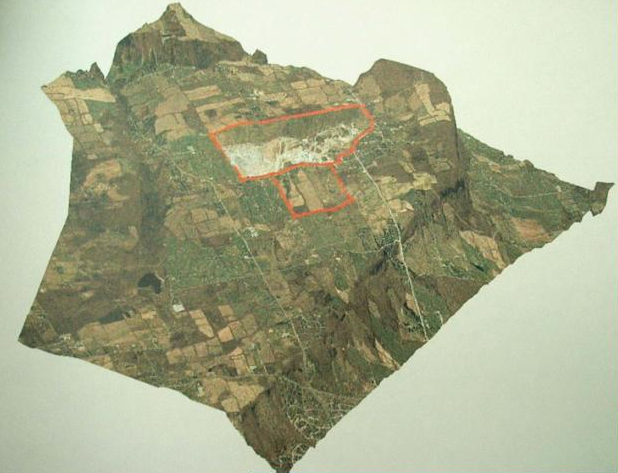 The orange outline at the top of this topographical map is where the current quarry is located. That mine is nearing being mined-out. The smaller outline is where Nelson Aggregates wanted to open a new mine. The application for a permit to do that was denied – a huge step for the rural community. Ecotourism was mentioned several times – but other than tossing out the phrase there wasn’t much more meat on that bone. One lady suggested opening up B&B’s – great idea and there isn’t a thing stopping anyone from putting out a shingle today. But even a dozen B&B’s aren’t going to make much of a difference to the local economy or the health of the community. They won’t hurt and if done properly they would introduce more people to what we have and those visitors would speak well of our rural north.
This is the time to do that thinking and at this point there isn’t all that much quality thinking being done. Nemo 7G is in place but other than a large poster that I couldn’t make much sense out of – they’ve not come forward with very much. They do want to think ahead for seven generations – which is laudable, great if they can do it – but we’re not seeing it yet.
Environmental issues are always on the front burner for the people who live rural lives. They know what they have and they know how quickly it can be destroyed. The quarry battle has been fought and won; the Stop the Escarpment Highway battle has been fought to a win – sort of. One never knows what the bureaucrats are thinking and the people paying the bills are usually the last to know.
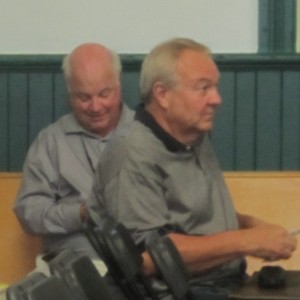 Ward 3 Councillor John Taylor, the person who probably works hardest to ensure that rural Burlington does not get turned into another suburb sit with John Timmis at the Lowville school house. Taylor wants to change that and he knows that if he can mobilize the community a significant difference can be made. It takes a lot of work on the part of citizens to attend meeting after meeting and struggle to raise the funds needed to fight powerful interests. PERL (Protect Escarpment and Rural Lands) is exhausted. They won the fight to prevent Nelson Aggregate from getting another permit to quarry rock out of their holdings at Guelph Line and Colling Road but in the process burnt out a number of people who were heavily involved in the Joint Tribunal hearings that went on for close to a year. PERL won – and the community is grateful – meanwhile PERL struggles with debts and have yet to hold a community wide event to celebrate what is a truly astonishing feat.
This business of fighting powerful, well financed interests can grind you down.
One woman thought there was an opportunity to develop an “interpretive centre” on the quarry site while another related a conversation she had overheard in a coffee shop that had the owners of the Mohawk Raceway putting together plans to turn the quarry site into a resort – convention centre with an upscale hotel. That speaker wanted to see a lot more transparency in whatever gets done.
Some of the people who live in the rural community want more in the way of amenities – “there is no place to walk in Kilbride” said one woman. There are apparently no trails – just roadways.
Just about everyone wanted clean, renewable energy – but no wind turbines; solar was acceptable and geothermal was described as the best deal available.
Bike lanes on Walkers Line – a gotta for these people but not so gotta for the farmers who need to move wide equipment up and down those roads. The Bruce trail needed to make better use of the countryside – too much of the trail is along the roadway in rural Burlington.
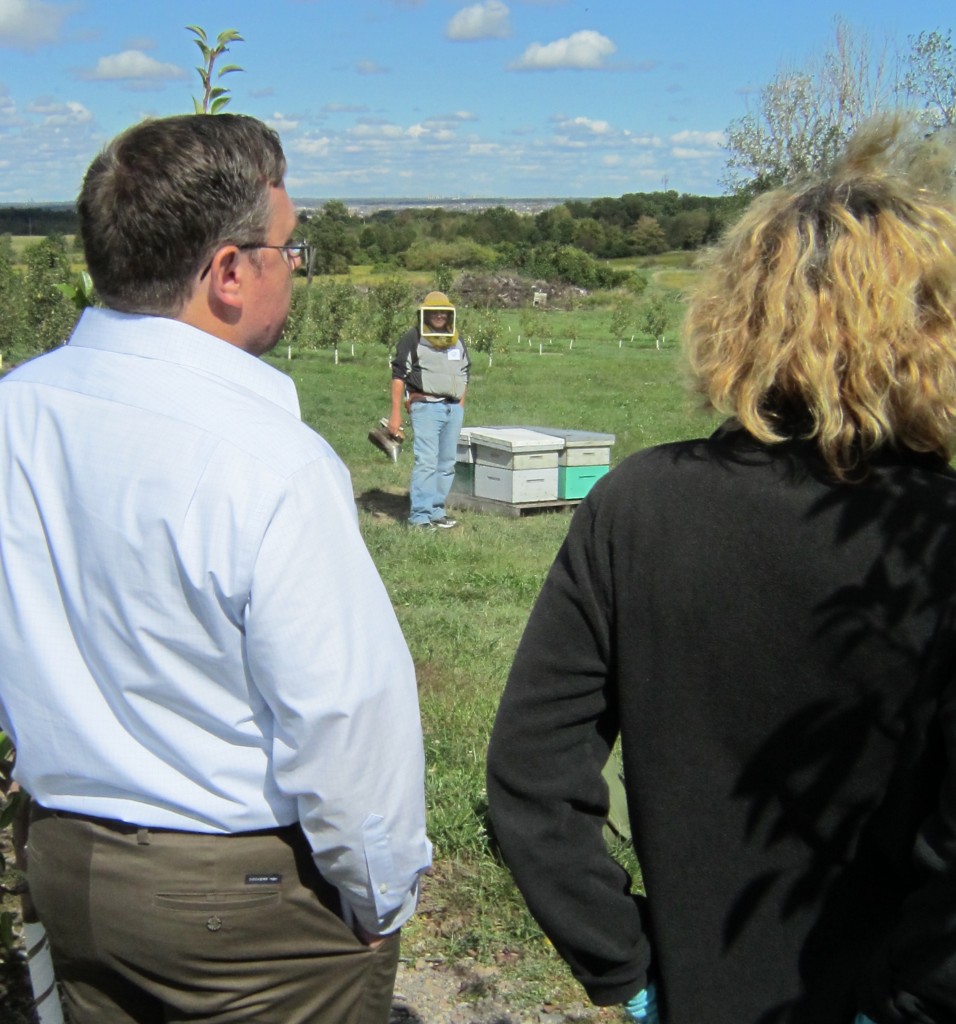 Bee keeper showing people on a farm tour how the bees are maintained and used to pollinate pear trees on a farm on the north side of Dundas just west of Guelph Line. Thousands drive by the place without knowing how big the place is. Another speaker said there is a strong story to be told about just how economically viable rural Burlington is – with about 2000 homes in the defined area it’s difficult to see an economic core. The sum of the agricultural interest, the services the equestrian community provides, the traffic that Lowville Park attracts and the number of really small farms don’t add up to much in the way of economic activity. The biggest job creator has been the quarry. The golf courses are always busy – but are they placeholders for land that might one day get developed? Do the golf players spend money outside the grounds? The Lowville Bistro is business enough during the season and if properly marketed they could extend their season to close to year round. Is there a reason why there aren’t more decent restaurants in rural Burlington?
Someone within rural Burlington needs to do the homework to tease out the economic base – because it wasn’t at all clear there is one.
The airport can’t be allowed to grow another foot seemed to be the sentiment of the room. Milton might have something they want to say about that and the people who are building the 3500 and 5,000 square foot homes want to be able to get to that airport and fly in and out. They have truckloads of money and they want to be able to spend it on the lifestyle they have chosen – which is to live in a quiet community where they can live behind electrically operated gates and do whatever they want.
That didn’t jive with the several comments about the wish for a cohesive community. The moneyed set don’t want to be part of a cohesive community – they want to be left alone.
The day was divided into two phases with a wrap up session. City hall Planning staff would then take everything back to their offices and begin to make some sense out of it all.
The facilitator did everything they could to get people into small groups – four or five at each table, where they were asked to listen to each other while each talked about what they felt Rural Burlington would look like 20 to 25 years into the future.
A recorder took notes.
Every 20 minutes all of the people at each table, except the recorder, moved to different tables and went through the same exercise but with different people. The objective was for people to listen to each other.
With Phase 1 complete everyone had lunch, which was provided. The facilitator then went through the notes and looked for common themes. They created spaces around the school gymnasium where they put up posters on each of the six themes they had identified.
Tourism, Agriculture, Natural Environment, Transportation, Sustainable growth, Cohesive Community.
People were then invited to take their chair to the theme that interested them the most and get into a conversation with others on what the theme meant to them; what Burlington is actually doing now; what will future generations say we have achieved – then, what are the big ideas – the possible projects.
And that was about as much as one could expect from 125+ residents who met on a cold Saturday to talk about what they wanted their city to include in the next version of its Official Plan.
The city had hoped to complete its Official Plan before the end of the current term. Councillor Taylor has suggested the job may not get completed before the end of the current term of Council.
The “retirement” of a key staff member has called for a number of adjustments that were not planned.
Nisha Shirali. an environmental planner and Alison Enns, the Acting Senior Planner on this project and Andrea Smith, Acting Manager of Policy and Research now get to go back to their offices and figure out what it all means and how to work it into the review of the Official Plan.

 By Pepper Parr By Pepper Parr
BURLINGTON, ON. January 21st, 2013 The Burlington Fire Department is looking for individuals who are interested in a challenging opportunity to serve their community as a volunteer firefighter. Applications are now available. The submission deadline is 11:59p.m., Feb. 1, 2013.
There are a lot of gotta’s with this opportunity.
You must be a Burlington resident and be at least 18 years of age.
Meet the volunteer firefighter requirements as outlined on the city’s website
Be prepared to volunteer your time to training, firefighting and other related duties
The Fire Department consists of both professional and volunteer firefighters. Being a volunteer firefighter is no ordinary job; the work is varied and challenging. New recruits will be assigned to Fire Headquarters, Station No. 1 located on Fairview Street or Fire Station No. 5 located in Kilbride based on where the applicant lives. The Kilbride station covers the rural areas of Burlington, mostly north of No. 2 Sideroad.
For more information about requirements, preferred qualifications and how to apply online.
While firefighting can be dangerous the men and women who do this work are exceptionally well-trained. Burlington firefighters did very well in a recent extraction competition.
In the past Burlington firefighters have been recognized for their bravery and public service. It is well paid work with a great group of people.
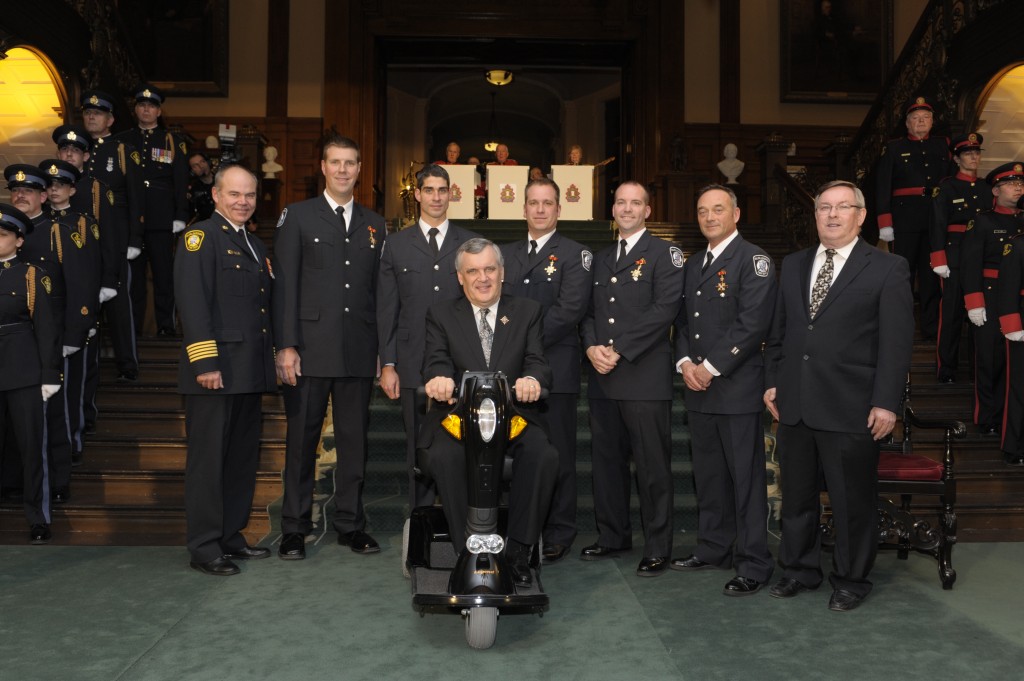 These Burlington fire fighters were recognized by the province for their bravery and excellent work. 
 By Pepper Parr By Pepper Parr
BURLINGTON, ON. January 21, 2012 Well you have to give them some credit for having the temerity to ask the city for close to $1 million to tide them over until we get into an election year when all hell will break loose over just how much the Performing Arts Centre has cost the city so far.
The Burlington Performing Arts Centre (BPAC) is asking the city for the $637,310 operating grant is usually gets.
It then wants the city to cover the $225,250 shortfall from last year.
Then add in $68,100 for a full-time technician and $63,600 for a full-time sales associate.
Those add up to $994,260 which is as close to a cool million as you can get when you have your hand out.
Can we expect these two additional staff members to require funding every year as things go forward?
While the Burlington Theatre Board, that group that oversees the Performing Arts Centre, will offer a justification for the amount they are requesting – one hopes that the council committee that will hear this request requires every blessed member of that board to be present in Council Chambers, the bald fact is that BPAC hasn’t figured out what it has to do to make the venue viable.
Their solution seems to be – just ask for more money. The Mayor who sits on the Board seems prepared to go along with the request.
Just so we are sure who to watch for in the room – the members of the Board, based on the most recent information we have, are: Allan Pearson, Chairman; Rick Burgess, Vice-Chair; Peter Ashmore; Robert Ban; Councillor Rick Craven; Ilene Elkaim; Jeff Fielding, City Manager; Mayor Rick Goldring and Denise Walker
You know for certain that if the Performing Arts Centre had a surplus to show for the 2012 fiscal year they would all be sitting there in their finest preparing to take their bows and accept the kudos of a grateful city.
Do we have artists trying to do accounting? It will be interesting to hear what the Performing Arts people have to say when they explain the need for additional funds. The city’s approach to budget development now is to require a Business Case for every increase in funding. In the document that council members now have BPAC sets out the base budget contribution as
$1,014,100 in 2014;
$1,034,400 in 2015 and
$1,055,100 for 2016
The base contribution just keeps inching higher and higher. The public wasn’t told to expect this when they bought into the project. It’s too late now to go back – the building is up and operational – the question now is – can we afford what we have? Are we doing this the right way? Are the right people in place?
BPAC staff are predicting that attendance from the 2013 – 73,000 will rise to 90,000 in 2013 and 96,000 in 2014.
And that ticket revenue will climb from the 2012 $549,450 to 656,000 in 2013 and $669,100 in 2014
Advertising, sponsorship and fund-raising will go from the 2012 – $250,000 to $260,000 in 2013 and 265,200 in 2014. These numbers appear to have some reasonableness in them.
Rental revenue is predicted to climb from the $280,000 in 2012 to $368,675 in 2013 and then to $376,000 in 2014. Given the difficulty with rentals to date these numbers just might have been written by an accountant whose fingers were crossed.
Everyone wants the Performing Arts Centre to succeed. But wishful thinking serves no one – we need a Centre management that tells city council what they need to hear and not what they think council would like to here.
BPAC has a bit of an operating surplus – require them to use that and if they still don’t have what they need to meet the payroll – welcome to the real world. Reduce costs. The Business case suggested that not implementing the additions might result in mice – call the Humane Society and get a couple of cats.
Sometime in the summer a piece of public art will get placed just outside the building. If what we’re being told is true – it has the potential to be quite something – but is the public going to fully appreciate what Dan Lawrie has chosen to put $37,000 into or will it become part of a joke that is attached to a building we can’t afford.
Burlington needs what the building is all about – but Burlington also needs efficiency and prudence with what public money is spent on. Have we not learned the pier lesson yet?
Last time around, in 2012 when Executive Director Brenda Heatherington was asking for $624,814 she told a council committee that they were able to balance their 2011 $1.65 million budget.
Ward 3 Councillor John Taylor responded – “that’s music to my ears” and went on to add that “If you do that this year, you will have exceeded my expectations.” Expect the sound of clashing symbols and beating drums from Taylor, who has never felt the place would pay for itself, when the request to cover the 2012 shortfall gets discussed at council committee the week of February 4th.
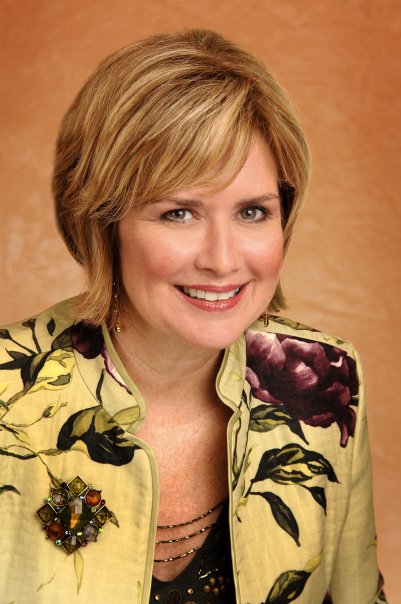 Councillor Lancaster will bring more than a pretty face to the budget committee meting when BPAC explains why they need the cool million they are asking for. Lancaster didn’t think the city was getting value for the $71,000 the Centre wanted in 2012 to hire a fund-raising person. At the 2012 meeting Councillor Lancaster questioned a sum of $71,000 + for someone to do fund-raising and sponsorships with the hope that $90,000 would be raised. Lancaster said that her experience was the fund-raiser would bring in two to three times more than they cost.
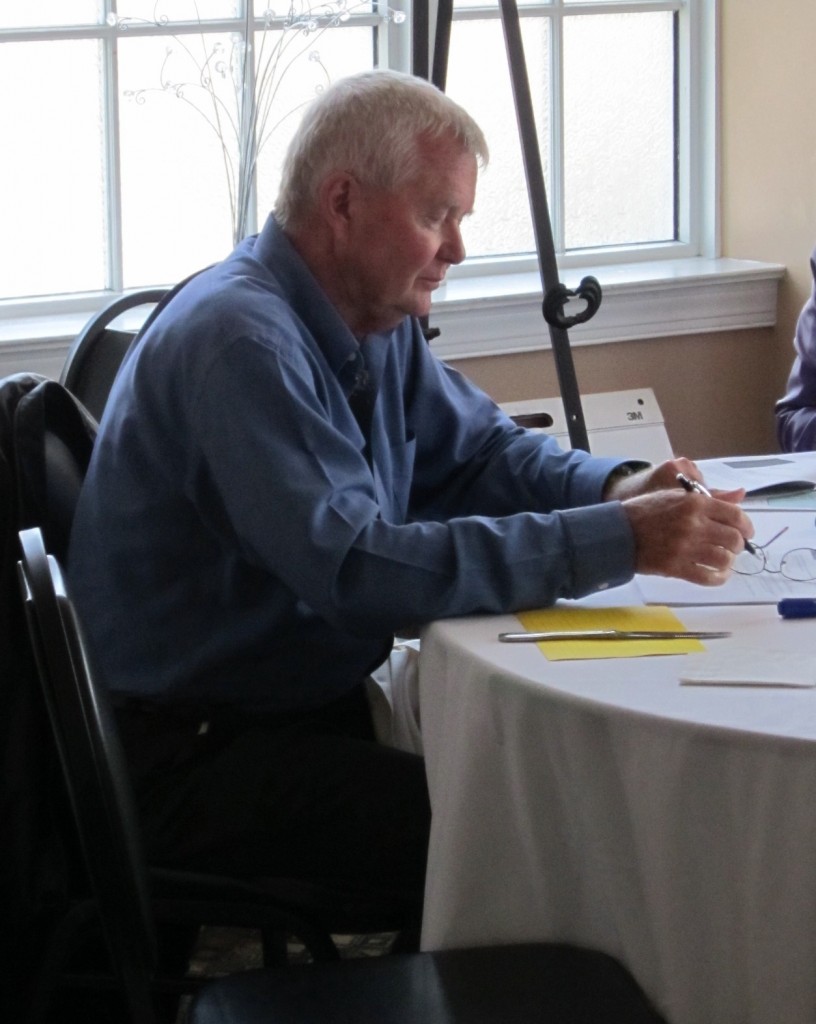 Ward 4 Councillor Jack Dennison not only does his homework but he tends to be the most direct when it comes to asking the hard questions. Expect him to bring a bit of a hard edge to the discussion over the close to $1 million BPAC wants for 2013. Councillor Dennison, who is always tough on the spending side, wanted to know how the BPAC people managed not to include the parking levy, the need for a janitor, the need for someone to clean the plate-glass in their staffing model. He also wanted to know why they didn’t see the need for a ‘development associate’ “How did we miss these?, he asked in 2012.
“We had a staffing model set up and that was the staffing model you said you needed and now you’re back looking for additional staff,” he said.
Heatherington explained that “you start a business with the staff you think you need to operate . She added “they anticipated adding a position for 2012”.
BPAC projected sponsorship, advertising and fundraising to bring in $250,000 in 2012 – that didn’t happen.
Councillor Dennison commented on the number of “dark nights” which were explained away as staff using the holiday time last year to recover from a very hectic opening schedule.
The BPAC opening events were great. The McLaughlin Gala cost a fortune but most of the cost was covered by the $400 admission price – to which all the tickets were not sold. Some had to be given away to fill all the seats. The Centre and its staff along with the Board were on a bit of a well-earned high.
That allowed them to get what they asked for in 2012 –it will be a different conversation this year.
 Keith Strong, the guy that muscled the building of the BPAC and ensured that it came in on time and on budget. Could have been chair of the Theatre Board – he’d earned it. He almost single-handedly ensured that Jane McKenna got nominated and then elected at the city’s MPP. Can he work some of that tough guy stuff on BPAC’s financial practices? Building the Performing Arts Centre came to $41 million. A very large part of that cost was raised by the team of people who promoted the idea, raised the funds, oversaw the project and ensured that it came in on time and on budget. Keith Strong headed up that effort.
The city provided $743,500 in funding in 2011, came back in 2012 to ask for $490,314 – which they said then they needed to cover ongoing program changes for $134,500, which includes $71,200 for a development associate position and $63,300 for building maintenance costs and payment of BPAC’s downtown parking levy. The parking levy was a contentious issue between the city and the Burlington Theatre Board who at the time didn’t realize everyone in the downtown core paid a parking levy. In this case it really amount to BPAC asking for money to pay the parking levy and then giving it back to the city to pay the parking levy.
The 2012 BPAC budget was $2,864,000 of which the city was asked to kick in $624,814. That year the city put up 22% of the money needed to run the place.
The 2013 budget is $2,938,165 with the ask amounting to $994,260 – which amounts to 34% . And these guys don’t pay rent for the space they use.
Mayor Rick Goldring defended BPAC during the 2012 budget debates. At the time he said: “This is a first-year operation and we want to make sure we create every opportunity for the board and the staff to succeed and I suggest we get out of the way and let them do their job.”
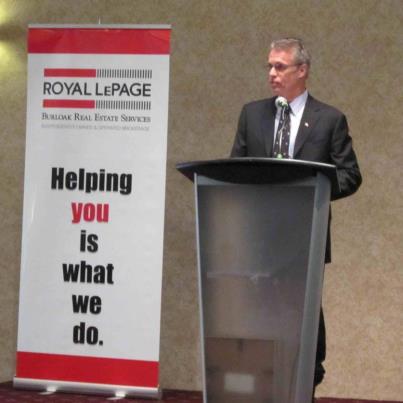 Mayor Goldring is a tireless advocate for the city. He is out at every event he gets an invitation to attend talking up the city. That’s part of the job – the harder part is bearing down on small problems before they become big problems – and the BPAC funding request is about to become a big problem. That was in 2012 – in 2013 the Mayor is reported to have said: “The reality is this is a new business and it just completed its first full year of operation and it is going to take maybe three years to find the right balance in the community in terms of what Burlington is looking for as far as entertainment and culture,” said Mayor Rick Goldring, who sits on the theatre board. “Also, it is going to take some time to generate additional rental revenues and reach out to the community and beyond to fill in additional dates.”
Different tone between 2012 and 2013.
Ward 2 Councillor Meed Ward didn’t support all of the 2012 budget request. Both she and Councillor Dennison moved that portions of the funding request be struck but both were voted down by a majority of council.
We’ve not had a chance to talk to Councillors Craven and Meed Ward.
Heatherington said BPAC would make an effort to find more sources of funding in future. BPAC got a pass in 2012 – they aren’t going to be as fortunate in 2013.
At some point the Theatre board is going to have to introduce a dose of reality into the way they are funded. That may take ‘three to four years’. Council can introduce that reality this year by doing their homework, reading the reports and pouring over the numbers. Their job is not to micro- manage but someone has to look at the problem – the Theatre Board certainly isn’t.
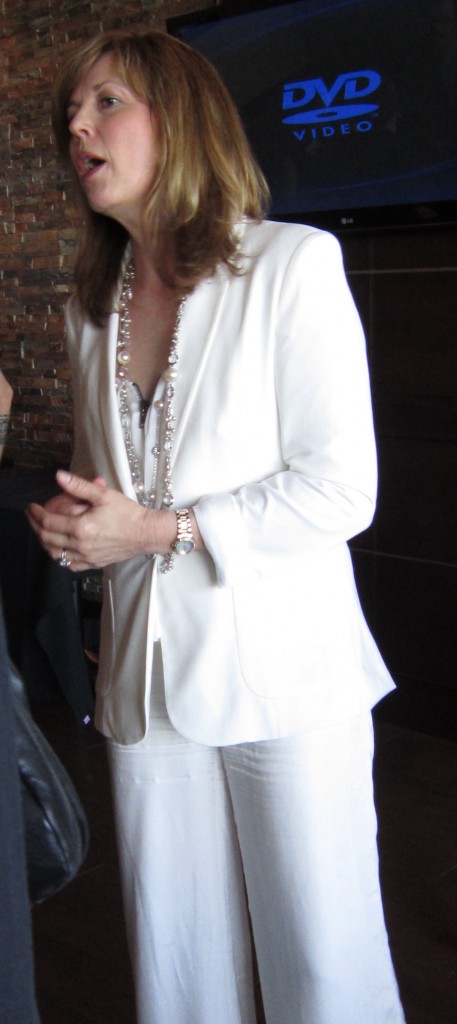 Brenda Heatherington brought a sterling resume to her interview. She had the reputation and the experience Burlington felt it needed. Her experience in Alberta has the potential to make BPAC a great place. However, she may need some help with the financial management side. Heatherington came to Burlington with a very impressive resume. The city took to her and loved the way she bought into the dream. No one knows better than Heatherington just how hard it is to get something like a Performing Arts centre off the ground. It takes time – and the city has given her some time – she now wants more.
They have missed their targets on rentals to the community despite calling everyone in business who has a telephone and following up on those that expressed even a hint of being interested. Was the rental projection too optimistic? Or was the person doing the selling not good enough? We don’t know.
Sponsorships ad grants have not materialized. Were the projections unrealistic or did the financial landscape change. We don’t know.
Who buys tickets to events? Does BPAC have that data? If they do – they’re keeping it under their skirts. When you need financial counseling – and a short fall of $225,000 plus means you need financial counseling – then you open the books and get the help you need.
Has the Board issued a statement on the condition of the organization they oversee? We’ve not seen one but then we don’t get press releases from BPAC; haven’t had one since we did a piece they didn’t like back in 2011. Before that piece we had one senior member of BPAC staff saying we were the “best thing that has happened to Burlington in a long time”. We said the Board was irresponsible then – looks as if they are still irresponsible.
Being a member of the Theatre Board is not a social plum; it is the recognition by the community that we believe the men and woman chosen are capable of identifying the problems when there are problems and then taking the necessary steps to resolve the problems. We call that good governance.
On two occasions that I can recall while sitting through council committee meetings I have heard city manager Jeff Fielding apologize twice for mistakes that were made. One of them wasn’t a mistake he made but he apologized nevertheless. Brenda Heatherington might be well served by going to the city website and watching a responsible manager do what has to be done – manage openly.
BPAC has indicated they expect to need more than was planned for the next number of years. This is the time to ask the hard questions.

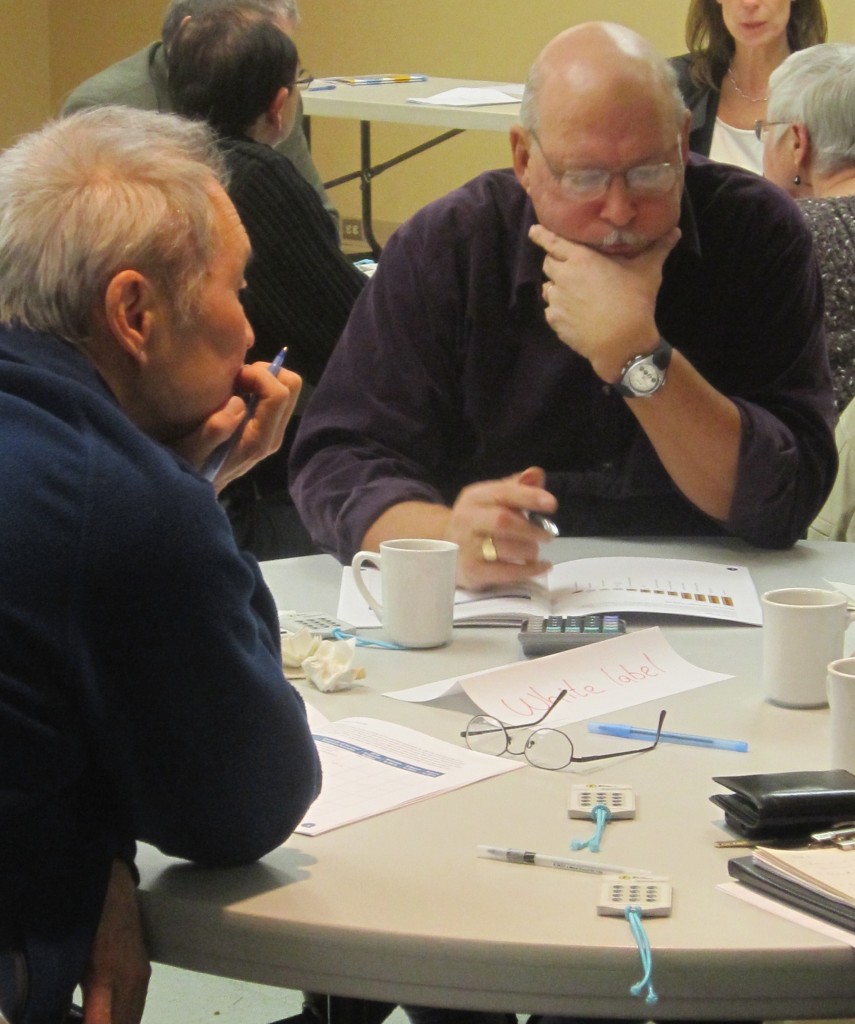 When citizens, be they people involved in non-profit organizations or on civic committees get together – things happen. The Region is sponsoring an event that will pull together all the non-profits to Talk and Connect. 
By Pepper Parr
BURLINGTON, ON January 17, 2012 The Region of Halton is going to host networking series for non-profit sector to create opportunities for conversation, networking and learning to strengthen relationships within the non-profit sector.
The “Let’s Talk…Let’s Connect” series starts Wednesday, February 13, 2013 with a session facilitated by Paul Born, president of Tamarack: An Institute for Community Engagement and author of Community Conversations.
The session takes place from 9 a.m. to 12 p.m. (registration and light breakfast starts at 8:30 a.m.) at the Milton Sports Dome (605 Santa Maria Boulevard, Milton).
“Through many different initiatives, Halton Region regularly partners with the non-profit sector,” said Regional Chair Gary Carr. ”As part of our commitment to working with the sector, we are bringing people together to build strength in the non-profit sector to achieve their organizational goals. Building “capacity” supports the sector to manage services now and in the future.”
That “capacity” words might be working at the Regional level but Burlington is struggling with just what it means as it works it’s way through the creation of an Engagement Charter between the city and its citizens.
Building capacity in the non-profit sector is an action in the Citizen’s Priorities – Halton Region’s Action Plan for 2011 – 2014.
The “Let’s Talk…Let’s Connect” series seeks to connect people and ignite conversations about opportunities for collaboration that will help the sector achieve its goals. Paul Born’s session on February 13 will explore the power of multi-sector conversations for creating social and economic change in Halton. Participants will hear about Halton initiatives that began as conversations and are currently creating change in our community. The session is a great opportunity to share ideas, resources and discuss current trends.
All sectors are invited to participate in this networking series. Government, the non-profit sector, the private sector and funders can all make important contributions to these conversations.
To register for the first session or to learn more about the series please dial 311 or register online.
Sessions two and three for “Let’s Talk…Let’s Connect” will take place in June and October 2013. Topics will be determined based on discussions at the first session.

 By Pepper Parr By Pepper Parr
BURLINGTON, ON. January 16, 2013 While the part of Lakeshore Road that has the heavy traffic, and on which the city wants to paint lanes for exclusive bicycle use, is not in Ward 1, Councillor Craven assured a Workshop talking about how to better engage the community, – that there will be letters galore on how stupid an idea bike lanes on Lakeshore is. A view we must add which the Councillor does not share.
The different views on bike lanes on Lakeshore Road got trotted out at a four-hour meeting Monday evening at which council heard 12 delegations that basically broke into two camps – those who believe fervently that we will be healthier and the environment will survive if we can get cars off the road and those that believe they have the right to make left hand turns off Lakeshore into their driveways.
Issues like this are the bane of every politician – they can’t win. At least half of their constituents are going to be unhappy. This is the time when the politicians have to rise above their local interests and go for the better good. And on Monday night – they, for the most part, did just that.
It would have been one of those 4-3 votes that used to plague Burlington but with Councillor Taylor away it came in at 4-2 with Councillors Meed Ward and Sharman voting against the six to nine month pilot project city staff has proposed.
While there were solid arguments from intelligent people on both sides what was evident was the split in thinking. Great idea said Councillor Meed Ward – just not on Lakeshore Road,
 Ward 4 Councillor Jack Dennison, the only one without a helmet, doesn’t that tell you something, is an avid cyclist who has put his money where his mouth is. His popularity will be tested when the lines get painted on Lakeshore Road. Jack Dennison, who lives on Lakeshore Road and is the Councillor for that part of the city explained very carefully that this was just a pilot project, but the intention is to eventually provide bike lanes for the full length of Lakeshore Road – from the canal on the west end all the way to the Oakville border.
The cyclists and the environmentalists believe the time has come to take serious steps to lessen car use and Monday evening they got past the first hurdle. Council committee instructed the Director of Transportation Services to conduct a trial re-marking of Lakeshore Road between east of Seneca Avenue and Guelph Line to provide on the road bike lanes and to report back to Council in the Spring of 2014 on the results of the pilot.
There are some complications in that the Region is digging up part of the road and exactly when that work will be completed isn’t certain. When you dig a hole in the ground to get at a water pipe – you never know what you are going to run up against – so timing gets a little iffy.
Some of the residents along Lakeshore brought good arguments to the table – but nothing they said was reason enough not to do a pilot. Right now all we have are a lot of strong feelings on both sides. Some data will help.
The city ran into the same problem when it put in the bicycle lanes on Walkers Line and Appleby Line south of New Street. The world was going to end – but it didn’t. There haven’t been any problems – however, there hasn’t been a huge increase in bicycle use along those stretches of road either.
Does it need more time for the city to know if the Appleby and Walkers bike lanes were a good idea that is being used by citizens? Probably too early to tell and it will take some time to learn if the volume of traffic on Lakeshore Road can accommodate bike lanes on the north and south side of the road, and if it is truly safe as well?
The cyclists believe it can be made safe while the people who live along the road or adjacent to it can only see long lines of cars backed up while someone waits to make the left hand turn into the street they live on or their driveway.
Jim Barnett, who lives on Shoreacres said that he has faced occasions where he has had to wait for more than five minutes before there was a chance to gun his engine and slip across the oncoming traffic. Dr. Margarett Ackerman spoke for herself and a number of residents and said that it was always very difficult to make the left hand turn into her hone when she was returning from the Joseph Brant Memorial Hospital where she is an emergency surgeon and told of a situation when an obstetrician was not able to get to the hospital on time to handle a delivery.
Mention was made of back-ups that are 50 cars in length that sit waiting for the person at the front of the line to be able to make that left hand turn.
There were exaggerations all over the place. Ken Love, the first person to speak spoke of the damage that cars do to our individual health and the environment; but what he had to say and his bombastic approach was so far over the top that he didn’t do much to advance the argument for adding bike lanes anywhere in the city.
 One of the few occasions you will see Councillor Meed Ward or Mayor Goldring on a bike. Councillor Dennison bikes, roller blades – big on physical stuff. Photo op promoting the two Car Free Sundays Burlington held in 2012 Councillor Sharman spoke of his concern for some of his elderly residents in Ward 5, who might die while in an ambulance that got tied up in traffic.
Meed Ward said bike lanes were a good idea – just not on Lakeshore Road. New Street or Fairview was her choice for bike lanes. Meed Ward does not use a bicycle.
It was hard to tell, while listening to the delegations, which way this council was going to vote. The Mayor will usually always side with the environmentalists – but you only see him on a bike during a photo-op.
Councillor Craven surprised us when he voted for the pilot project as did Councillor Lancaster when she voted to try it. Lancaster tends to identify with the hard-core Tory crowd along the Lakeshore and doesn’t usually go out on a limb. Her vote was the one that made the difference. Councillor Taylor was not able to attend the council committee but made it known that he did not support the pilot.
Dennison, a very active cyclist, takes the view that car drivers do not own the road – the road is there to be shared by cyclists and car drivers.
The bicycle crowd put forward some pretty solid data and they brought forward enough good argument to make the trial worth talking a chance on.
The issue for the cyclists is “quality of life”. They know that Burlington is not going to be like our sister city Apeldoorn, in Holland, where a very large part of the population does not use or own a vehicle – Apeldoorn is basically the same size as Burlington and about as far away from Amsterdam as we are from Toronto.
The Dutch will be in Burlington sometime in the not too distant future to open up a commemorative park – might be a good idea to put them all on bicycles and listen to what they have to say about bicycle use in a municipal setting.
The cyclists believe that if you build it they will come. Which is just what the Lakeshore resident fear – that the cyclists will come and muck up the flow of traffic, making it worse than it is now.
“If you add bike lanes more people bike; cyclists go out of their way to use bike lanes.” That kind of statement sends shudders along the spines of those who live along the Lakeshore.
“We are all much healthier if we bike and get the exercise we need,” say the cyclists. “We agree” say the Lakeshore residents “and the city has all kinds of bike trails where you can do just that”.
 Who uses a bike in Burlington? There are the Strong and fearless (1%) – you see them on the road in the middle of winter. There are the enthused and confident; people who use their bikes frequently and would like to use them more – 5-10% of the cycle crowd. Then there are the no way, no how people, you will never see them on a bike, they make up 30% of the demographic. It is the 60% who are interested in using a bike but concerned about their personal safety. This is the target market and these are the people the cycling committees want to see on Lakeshore Road. The bike people want less hysteria, more facts and measurements. They would like to see the left hand delays measured; they want to know just how many bike car accidents there have been as well. During the Council committee the audience was told that there had been four accidents involving bikes over the last four years in the stretch of the road where the pilot is to take place.
Councillor Sharman, who is strong on data, gave Vito Tolone, one of the city’s traffic experts, a very tough time over the lack of data. Tolone didn’t deserve the punching around he got; there was no need to manage him quite as aggressively. It’s an approach Sharman chooses frequently – one hopes that when the data is available he will make good use of it and not exploit it shamelessly to convince his constituents that he is doing a good job on their on their behalf.
Lakeshore Road is between 9.6 and 9.75 metres wide from Seneca to Guelph Line. It widens to more than 10 metres east of Guelph.
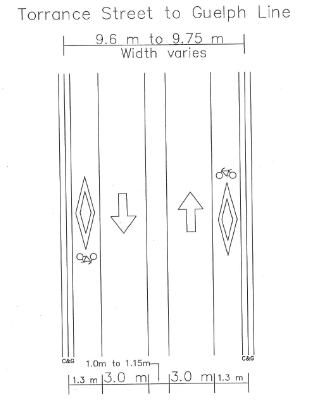 The pilot will run from SENECA, not Torrance, east to Guelph Line. The pilot plan is to reconfigure the road and mark it so that there is a bike lane on each side that will measure 1.3 metres in width. There will be two traffic lanes 3 metres in width. These two traffic lanes will be separated by a lane – NOT a turning lane – that will be between 1 and 1.15 metres wide. It is a lane that cars can edge into when they want to make a left hand turn.
Can it work? We won’t know until we try. Will traffic still back up? Of course, we’ve done nothing to decrease the amount of traffic on the road. That’s a traffic engineering problem; a traffic management task – bicycles are not going to make a difference to the number of cars on the road. The proposed plan will reduce that turning lane and that might result in a line of cars building up behind the car that is trying to make the left hand turn. If the turning lane were made 5 metres wide – it still would not change the volume of traffic nor would it allow cars to make left hand turns any faster.
Those arguing against the creation of dedicated bicycle lanes are not looking at the bigger picture – which is to reduce the number of cars on the road.
The bicycle people argue that the world has changed in 20 years and that the youth of today are not jumping into cars the way previous generations did. They point to a study that has younger people not buying cars and that demand will be down by 2 million units a year.
They point to data that has the percentage of 20-to-24-year-olds with driver’s licenses at 92 % in 1983 but currently at 81%; that could well be because this demographic can’t get jobs and have too much student debt to manage –but the fact appears to be that there are more younger people who have chosen not to drive a car.
The right decision, say the cyclists, is to widen Lakeshore Road – that option has a $9 + million price tag attached to it – which is half what the pier is going to cost us.
The next best, from the cyclists point of view, is to add segregated bike lanes to the existing road.
Burlington created two Car Free Sundays last year. The one on Appleby Line was successful but the one on Brant Street was close to a disaster.
Nevertheless, there is a core commitment on the part of this city council to get more people on their bikes. The pilot made it past the council committee stage. Council member phones will be ringing; the emails will flood the in boxes of every council member. Will they stand their ground or will they buckle – they are politicians. The ones to watch are the Mayor and Councillor Lancaster. We just may see what they are really made of.
Why is traffic on Lakeshore such a mess? Where do the cars come from and is there anything that can be done to divert traffic? If one wonders what traffic on the QEW is like all you have to do is check out the flow along Lakeshore. When the QEW is basically “stop and go” in spurts at that – traffic will cut south to Lakeshore where there is at least some movement. Is there some way to keep the traffic on the QEW and prevent it from drifting south the Lakeshore? That’s something traffic engineers have to work out.
 Concrete poured when the road was upgraded in the mid ’30’s. Known then as The King’s Highway it was THE route from Toronto to Niagara Falls. Lakeshore Road was originally known as the King’s Highway – Hwy #2 to many people. Construction began in 1917. In the mid 30’s the road went through a significant re-build. It is now a nice easy road through perhaps 50 communities between Windsor and Gananoque.
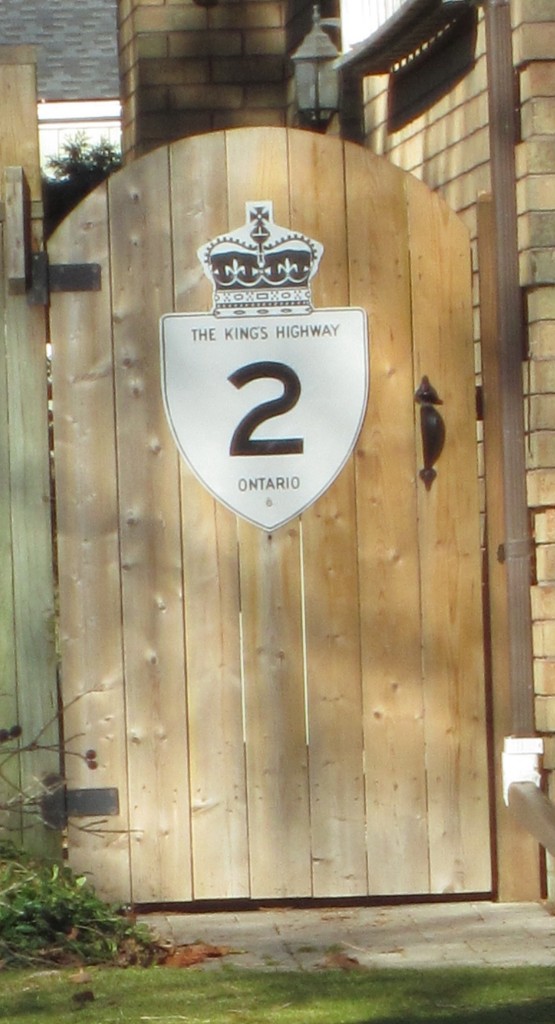 The old Highway name is now a decorative item for one of the homes along Lakeshore Road. What it becomes in the next 25 years will be at least as interesting as the last 25 years. It’s no longer a major highway. It many small towns it runs along the main street; in places like Burlington it is a road that could, if we let it meander along the edge of the lake where some magnificent homes have been built. It’s a wonderful drive through smaller, picturesque communities. We seem to have forgotten that in Burlington and see it as a road we should be able to zip along and at the same time treat as a street where we can turn into our driveway and not have to wait more than 10 seconds.
Change does not come about easily. For years most of us smoked; for years many of us never used the seat belt and for the longest time we felt it was OK to “have one for the road” and got behind the wheel of our cars when we really weren’t able to drive safely.
Times changed. Gas was cheap, we lived in sprawling suburbs where a car was vital – and they were fun to drive. You came of age when you had a car and the open road was all yours.
Now we are aging. For many that are in their 60’s their night-time vision isn’t what it used to be. Most of us know that there will come a time when our family doctors will have to tell the government we should not have a license. But we will be able to ride our bicycles for those small errands –and city council wants to have those safe cycle paths or lanes in place for that close upon us aging society to use.
Rob Narejko spoke to the Council committee as Chair of the Cycling Committee and said the information he was using was factual, with references to studies from accredited universities, government agencies who specialize in health and transportation. “You know my delegations are generally short and to the point”, said Narejko, “I regret, for both of us,” he added “that today’s delegation is much longer.”
 For Rob Narejko – this is the only way to go – slow speeds and roads with bike lanes. It is what he considers a quality life style. He drives a car as well. To put his remarks in context Narejko mentioned the value of strategy for continued viability of the City, the value of an active lifestyle and the value of the lines on the road.
“Nothing fails like success”, a quote attributed to many people and used by Narejko to show people have become comfortable with the way life is now. “They forget the work and tough decisions that got the city to where it is now and become complacent. The city gets stagnant, unable to attract business investment. Taxes rise, residents become disgruntled and before long, a once prosperous city is in decline” said Narejko.
Many people believe Burlington is a success. In this snapshot in time, it definitely is. But there are signs that show we are not keeping up.
Narejko pointed out that “Cars are a significant part of our city because we have designed our cities around the car. Cars are definitely needed as a method of transportation, due to the design of the city; just under 80% of people use their car for their daily trip to work.”
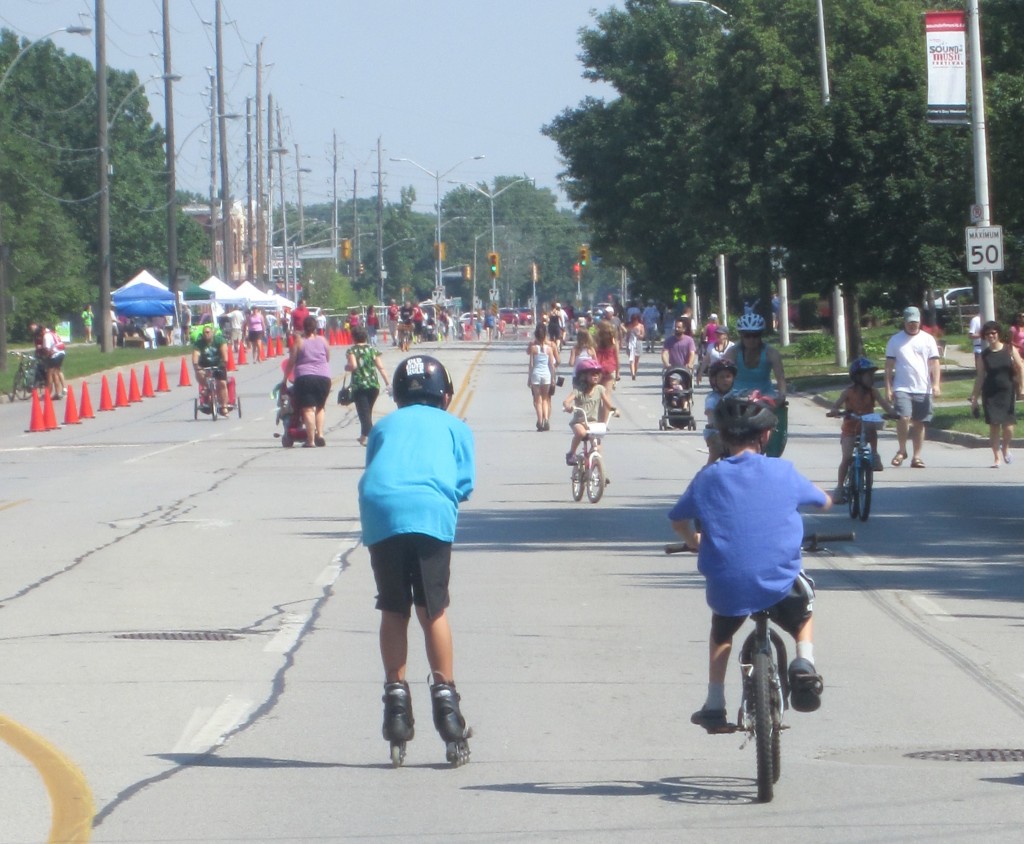 If it’s about “quality of life” this is probably what they are talking about. The Car Free Sunday on Appleby Line south of Fairview. One part of the city’s longer range project to get people using their bikes. “A city is about people: says Narejko. “People make the city work, not cars. Bikes, walking, public areas, green spaces are about people. It takes a crisis for most people to adopt change. Smart leaders don’t wait for a crisis. They create a vibrant plan for the future, through consultation with experts and the general public and then they carry through on that plan. If you don’t act on the plan, why go through the effort of creating them, taking up people’s time, spending money on experts and then shelving the reports? Do you want to be known as Councillors who kick the can down the road for the next Council to deal with when we are deep in trouble? Or do you want to be known as leaders who guided the City to the next level?
 Rob Narejko, Chair of the City’s Cycling Committee rides a bike, a motorcycle and drives a car. Does he ever take the bus? Rob Narejko maintains that Council was not elected to maintain the status quo. He isn’t going to get the level of agreement he expects with that argument – there are many, perhaps most people, in Burlington who are quite happy with the way things are – and they don’t want much in the way of change.
“Look at this issue” implores Narejko: “look at Guelph Line, Brant St, Walkers’ Line, Appleby line where changes were made: It is amazing to me how much people complain about minimal, positive change prior to it coming and then where do they go afterwards? Not a peep.”
“Has there been any negative feedback from any of the Guelph, Walker’s or Appleby projects? To my knowledge, gathered from City staff, no there have not.”
One of the dumber ideas Narejko suggested was that if traffic commute time is a priority on Lakeshore Road, then the city should pass a by-law that would permit only cars that belong to, and are driven by Lakeshore residents between the hours of 5:00 and 6:00 PM, Monday to Fridays. Narejko, who normally has useful argument, might want to pull that one.
Cycling, Narejko pointed out, is an accepted, legal and critical mode of transportation in all cities in all countries around the globe. He added that he could hear the nay-sayers piping up with: ‘yes, but not in Burlington’
Narejko and his colleagues point out that there are strategies developed by expert and rigorous processes to guide thinking at all levels of government which Burlington Council seems to ignore. There are five provincial initiatives (Places to Grow, Big Move, Strategic Cycling Plan (draft), Healthy Eating Active Living, Complete Streets) either in place or being developed as well as two Regional initiatives (Active Transportation Master Plan (under way), Active Halton) and then the city’s Cycling Master Plan and the Strategic Plan.
“It is very frustrating as an invested citizen in this community” said Narejko, “to have to fight for what should logically be done based on strategies and advice already in place.”
This initiative did get past a Council committee – all it has to do now is get through Council at the end of the month – without another dozen delegations please, and let’s get on with the six to nine month trial and see what the data tells us.
But it isn’t going to be quite that easy – is it?

|
|

























































































